#intentionaltravel
Explore tagged Tumblr posts
Photo

Craving the energy of Kauai 💙💚 www.beachbumwisdom.com #beachbumwisdom #transformativetravel #intentionaltravel #travel #wanderlust #blacktravel #blacktravelmovement #beachbumwisdomtravels #sacredtravel #sisterhood #tribe https://www.instagram.com/p/CLaxV5BLRvK/?igshid=ixr4fyntjese
#beachbumwisdom#transformativetravel#intentionaltravel#travel#wanderlust#blacktravel#blacktravelmovement#beachbumwisdomtravels#sacredtravel#sisterhood#tribe
8 notes
·
View notes
Text
Brasilia, Brazil
Few people have anything good to say about Brasilia, the country’s capital. Built from nothing only sixty years ago, it is now the third biggest city in the country, yet it draws few tourists. Even many “residents” leave on the weekends-- they are only here for work during the week and return to their home towns whenever they can. But from an architecture and urban design standpoint it is one of the most distinctive, unusual cities in the world, and that’s why I wanted to see it.
A quick history... For most of Brazil’s colonial history, cities along the coast competed to be power centers. Many agreed that the capital should be moved to a neutral location in the central interior, and the new republic’s Constitution of 1888 even called for it. But it wasn’t until after WWII that a president, Juscelino Kubitschek, put a plan into action. He assembled a team of designers and architects-- most notably Oscar Niemeyer-- to design the new city. In 1960 (59 years ago this week), Brasilia was inaugurated, and the capital officially moved from Rio. Niemeyer (who had strong communist leanings) wanted it to be the city of the future, where rich and poor would live and work side-by-side. His distinctive Modernist buildings still define the cityscape and were the main draw for me.
The main city of Brasilia is shaped like an airplane (it’s surrounded by 25 satellite towns too). The cockpit, fuselage and tail (the “Eixo Monumental”) contain most of the government buildings, museums and other attractions. The wings are divided into a grid and areas are named after what they contain, such as shopping, hospitals, sports clubs, etc. (Yes this is very strange as you would think it would behoove everyone to have these things spread around.) Beneath the wings is a large (manmade) lagoon. In many ways it’s a brilliant design (not unlike Burning Man) but it’s executed very poorly.
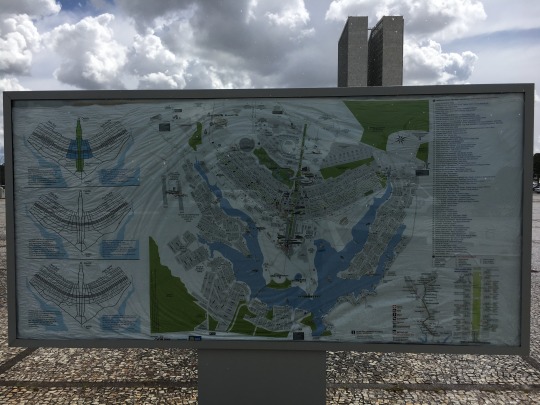
I arrived Monday afternoon to a relatively cushy AirBnB in the Hotel Saint Moritz in the “Northern Hotel Sector” (at the top of the fuselage). I needed some food, and the only real option was a giant mall (Conjunto Nacional) across the street. Brazilians love malls, and that’s especially true in Brasilia since there is effectively no street life (more on that soon). This mall was massive and yet there were no maps or directories. I really couldn’t fathom how that works tho I tried to as I wondered for half an hour to find the food court. That night I decided to take it easy, but I did enjoy the rooftop view of the axis.
On Tuesday morning I stepped out to begin my walking tour, which, if you’ve been to Brasilia, you probably find laughable. First, the distances are much bigger than they seem on a map, mostly because there is so much dead space to cross (lawns, parking lots, empty lots, grassy knolls, etc.). Two, Brasilia is famously made for cars, so there are few sidewalks or crosswalks. This means forging trails where you can (including on medians), waiting for a break in speeding traffic on four-to-six lane roads so you can run across, teetering on narrow curbs, walking in the street alongside parked cars, etc. It is extremely unpleasant, sometimes terrifying and often inefficient. It’s also surreal as when sidewalks or staircases (some of the few concessions made to pedestrians) just end abruptly at a busy road; the city planners know people will walk across that road but have done nothing to aid them. I know that in some places (like parts of southern California), the lack of sidewalks reflects that fact that nobody walks anywhere. But lots of people walk here. The problem is that they’re poor. The middle and upper classes drive cars, and city government doesn’t care about poor pedestrians. I suppose that Niemeyer thought everyone would drive in the future, and that’s why he designed such a sprawled city that can really only be traversed by car. But the result is a betrayal of his egalitarian principles (not to mention an environmental catastrophe).
Nonetheless I was determined to walk. Google Maps’ walking directions pointed me to... the mall. Yes Brasilia lacks sidewalks but you can take malls to get from points A to B. (Once again I got lost in the mall, so it took about 15 minutes to find B.) On the opposite side of the mall from my hotel sits a small plaza (hilariously named Praca dos Pedestres or “Pedestrian Plaza”) with a view overlooking the Eixo. It’s similar to The Mall in Washington, D.C., but it is not inspiring. You can see some of the stranger Niemeyer buildings along the axis and the Congresso Nacional at the end, but it’s mostly a large empty patch of grass that seems unfinished. My first stop was the Teatro Nacional, a sort of pyramid without a top that would make an awesome waterslide. Then I visited the Biblioteca Nacional, a fairly new (and incomplete?) building. It kind of resembles a hi-fi stereo from the 70s and looks great from afar. But up close it’s a terribly wasted opportunity. The ground floor of the building is encased in opaque glass windows so that it’s impossible to see inside-- or even get inside. I walked around the entire building before I found the drab entrance. Of all types of buildings, libraries should be accessible, open and functional, but it seems Niemeyer preferred grandiosity for one of his final designs.

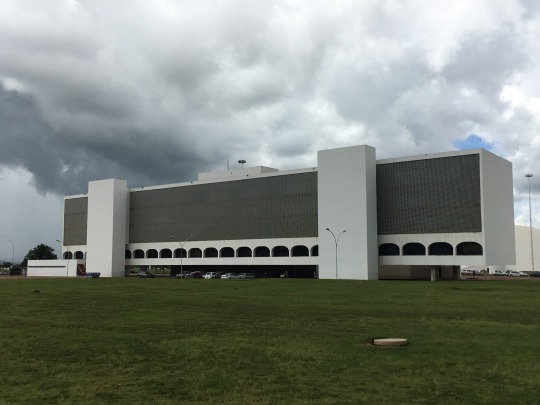
I continued on to the Museu Nacional and the Catedral Metropolitana, two of the city’s strangest, most recognizable buildings. They are both quite compelling in person, tho not well kept up and smaller than I imagined (or perhaps they’re dwarfed by all the empty space around them). The museum is a white dome with a Saturn-like ring around it and a large ramp leading to the entrance. It hosts rotating exhibits, but I was mostly interested in the building. The cathedral resembles a wheat bushel with leaning columns coming together in a peak at the top, separated by giant stained glass windows. The effect on the interior is unique and breathtaking.
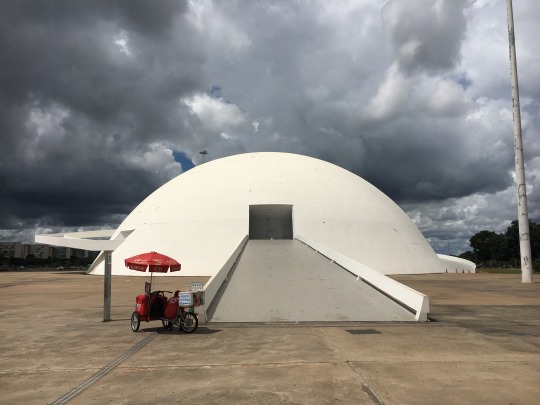
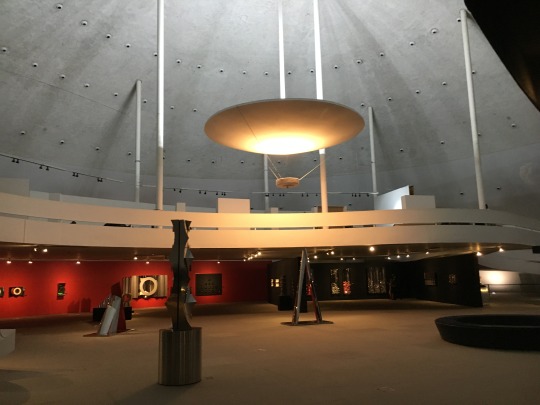


I then walked to the “Banking Sector” which has more to offer than you might expect. Brazil’s banks-- and especially the central bank-- often offer cultural centers and exhibitions centers, which at the very least can provide a good opportunity to glimpse inside some beautiful buildings. Case in point, the Caixa Cultural, a large bank whose lobby is filled with stunning stained glass windows, one for each of Brazil’s states. Across the street is the headquarters of the Banco Central do Brasil, a deceptively light looking skyscraper, that is home to a “money museum” featuring currency from around the world (unfortunately I could not go in without my passport).

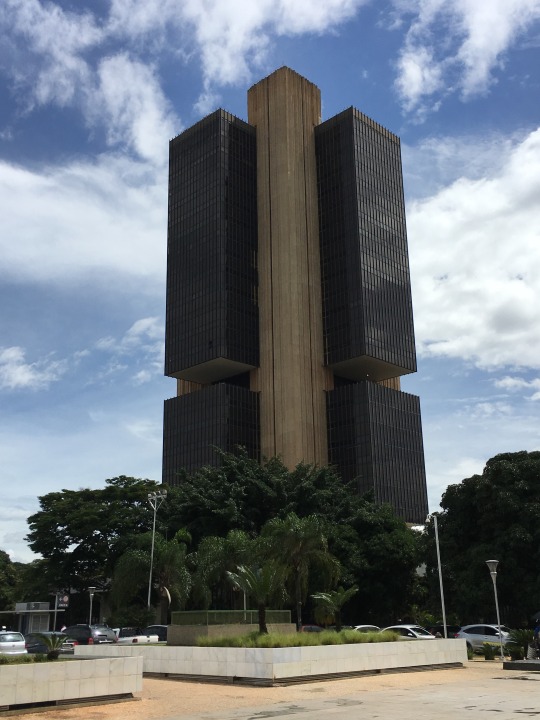
Cursing the traffic and city planners, I continued my walk, now scrambling south from the axis. My destination was Santuario Dom Bosco, a beautiful modernist church famous for its chandelier and illuminated Murano glass meant to resemble a starry night sky. It was also a nice place to sit for a minute and let my frustrations with the city subside. But that didn’t last long. I ventured back out and over to TV Tower, a broadcast tower that is one of the country’s tallest structures and offers sweeping city views. Supposedly. After a hot, lengthy walk dodging cars I arrived only to discover it was closed for construction. At this point I decided to treat myself to an Uber to get home, tho not before one last stop at... the mall. And yet again I got lost, this time in search of a grocery store which it turns out the mall doesn’t have-- apparently I should have gone to the grocery store sector. That evening I decided not to venture far from my hotel, which fortunately sits on a small plaza with a pizzeria, beer bar and convenience store.

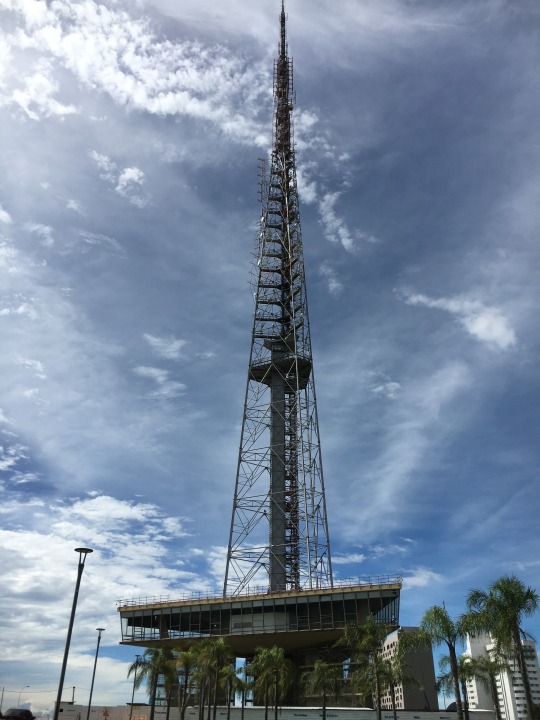
On Wednesday I set out (in an Uber this time) to finish my tour of the Eixo. I headed to Praca dos Tres Podres, the hub of the federal government. Sites include the Supremo Tribunal Federal (relatively dowdy); Palacio do Planalto (the Executive building which looks similar but its elevation on stilts makes it much more remarkable); Panteao da Patria e da Liberdade (a collection of striking geometric forms, including small dove-shaped performance space with a beautiful stain-glassed window, a stairway to an eternal flame and Brazil’s largest national flag); Espaco Cultural Lucio Costa (an underground lair honoring the city’s main urban planner which includes a giant scale model of the city); Museu Historico de Brasilia (a small, elevated marble block whose interior walls are engraved with the story of the city and several inspiring quotes about it, and whose exterior features a massive statute of Kubitschek’s head); and several art pieces. Up the hill are two beautiful buildings that house the Foreign and Justice ministries: Palacio do Itamaraty and Palacio da Justica. The former appears to sit in a lake that reflects the buildings columns and arches, while the latter’s exterior contains several cascading water falls. (Side question: if Brazil has not had a monarch since 1888 and Brasilia was built in the 1950s by a leftist government, why are all the buildings called palaces?)
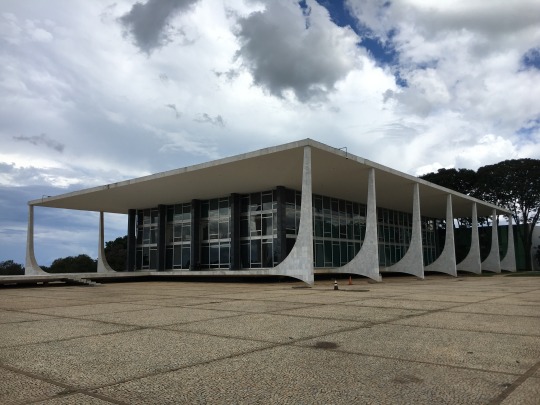

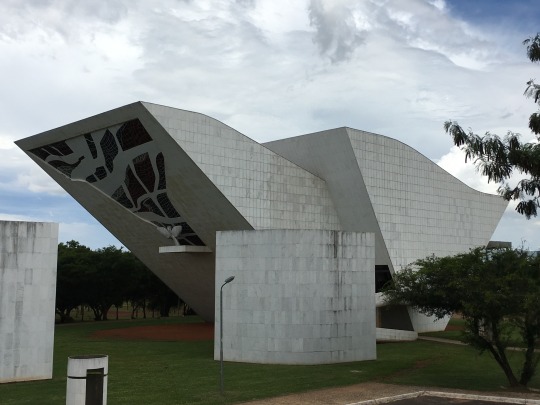


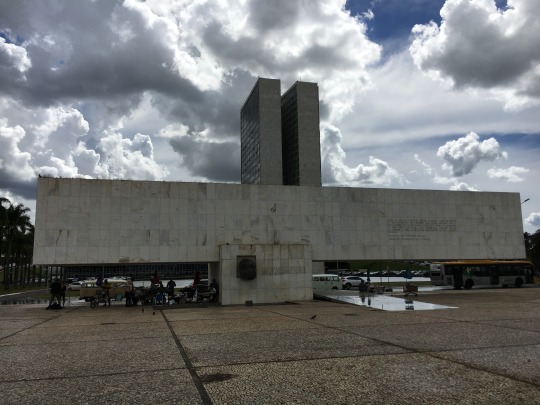

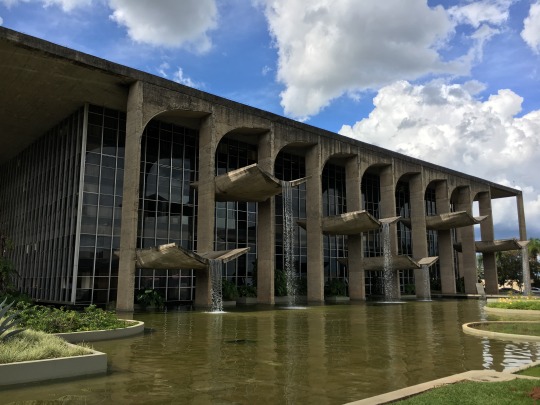
The centerpiece of all this is the Congresso Nacional, an eye-catching masterpiece rich in symbolism. Two tall, narrow towers intersect a low flat building with two roof adornments, a dome and a bowl. The dome (symbolizing inclusivity) tops the House chamber while the bowl tops the Senate. These are lined up neatly with the towers so that they balance each other out, tall and short, wide and narrow, heavy and light, square and circle. It’s really a perfect structure that I could not take my eyes off of as I walked around it.
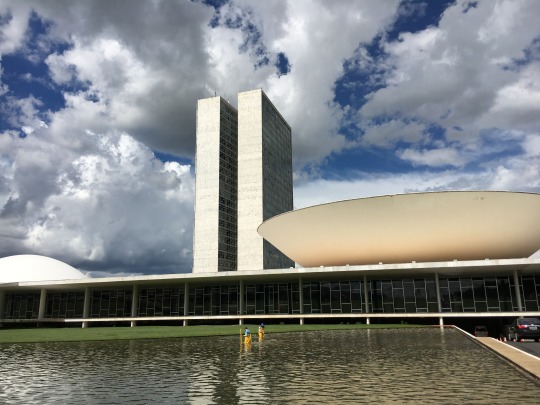
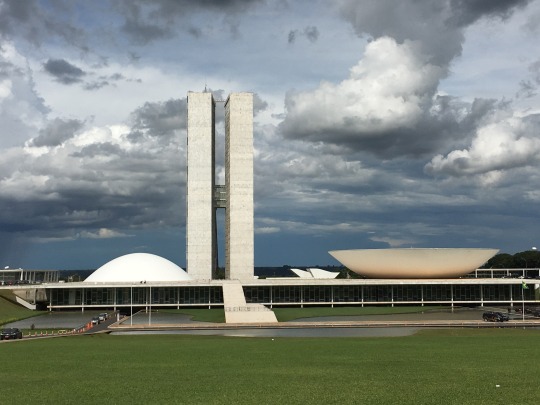
Once I had soaked in as much as I could, I took a car down to the “Sporting Clubs Sector” to the Centro Cultural Banco do Brasil, another bank-run exhibition space. This one is dedicated to contemporary art, and the current exhibition was on photorealism and hyper-realism, where artists use photographs to create amazingly realistic paintings that are able to convey qualities that the photography does not, such as depth, light, texture and social themes. The technical mastery behind these works was mind-blowing, and it yielded interesting insights into how different media and technology help each other to progress.
I then headed further south to Pontao do Lago Sul, a waterfront area with restaurants, performance space and meandering paths. It feels very new and contrived (like the whole city I guess) but it’s still a nice place to enjoy the light of the sunset. On my way home I stopped back at Praca dos Tres Podres to see it lit up at night, and I’m very glad I did.
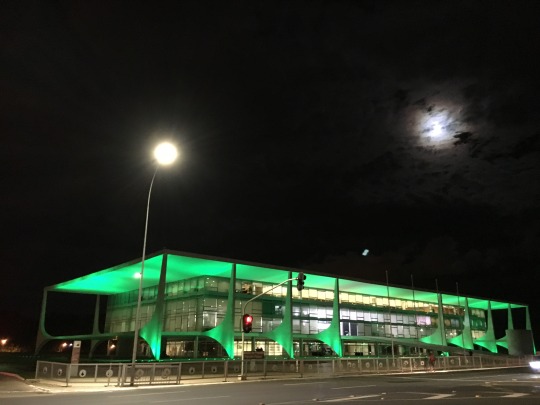
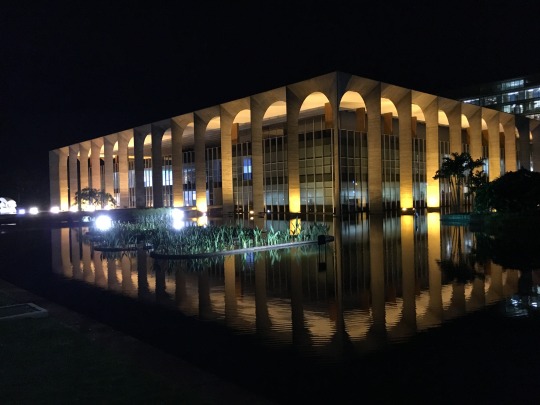
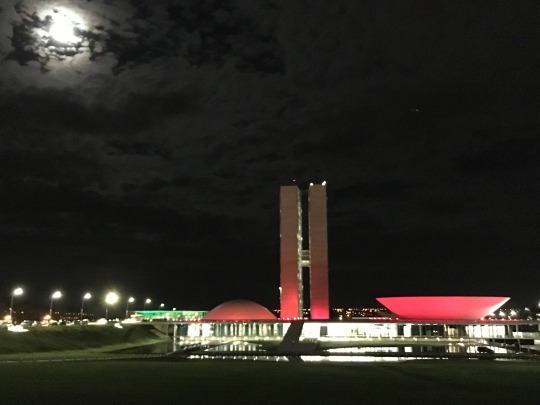
There was not much left to see on my last day so I spent most of the time relaxing and catching up on this blog. I stepped out for a moment to see JK Memorial, Kubitschek’s museum and mausoleum (in the cockpit). It’s a modest, tasteful building full of the president’s belongings (documents, medals, clothes, pens, 1974 Ford Galaxie, etc.). The displays were in English which is always nice, but I do not have a strong interest in Kubitschek so I breezed through quickly. I did enjoy the recreation of his library (with 3,000 books) and the many historical photographs, particularly those showing the building of Brasilia. I noted how much empty space lay between buildings during the construction. This is to be expected but one would also expect that space to be filled in over the next sixty years....
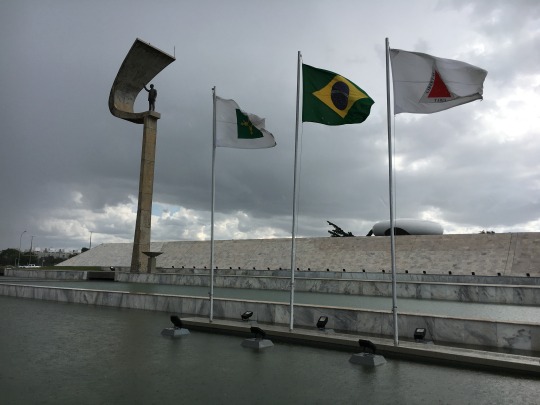
Brasilia is a city most people don’t want to spend much time in or think much about it. But it’s actually a fascinating place that made me consider the value of architecture and urban design. I loved the notable buildings here much more than I expected to. Concrete Modernism does not sound aesthetically pleasing, and I thought the city would look more kitschy, like Epcot Center. But these thoughtfully rendered buildings really opened my eyes to how beautiful modernism can be and how well it can age. Just as important, the city founders (especially Niemeyer) did not try to emulate existing world capitals like London or Rome. They created entirely new buildings that were-- and still are-- distinctively Brazilian. If a country’s capital should showcase its own aesthetic, Brasilia has succeeded.
And yet in almost every other way it is a failure because of-- not despite-- its (over) design. Contrast it with Sao Paulo, a city that has grown up entirely organically. Yes it’s a mess but it’s a much more exciting, livable, human city. Brazil’s cities have incredible street life but that’s pre-empted in Brasilia. This city offers a lesson that cities grow from the bottom up and cannot be handed down from above. Clearly the designers had an idea about how a city should work, but they completely ignored how they actually work. Good urban planners will take note of existing human behavior and patterns and accommodate them (for example, building parking lots) while encouraging better civic mindedness (like building bike lanes). It’s also foolish to design a city around a technology that’s only 50 years old (driving) while ignoring what humans have been doing for tens of thousands of years (walking). Like so much of Robert Moses’ concurrent work in New York City, this urban design sacrificed the city’s residents to the greater concept of the city.
It’s probably too late to fix Brasilia and all its wasted space (and there does not seem to be much will to), but some elements could be corrected, starting with the city’s ambivalence-- even hostility-- toward tourism. Despite its short history, Brasilia is a unique, important city with many attractions in relatively close proximity. It would appeal to a lot of people, especially architecture enthusiasts and Brazilians interested in their own government. And the people are much friendlier than in Rio (perhaps because in Brasilia people are grateful to have visitors whereas in Rio they are taken for granted). But the city does nothing to encourage tourism. There are no good options for getting around, and all of the government buildings are either closed to the public (a terrible look for a democracy) or are only open in small windows or under specific conditions. From an outsider’s perspective it seems they don’t actually want tourists here. Everyone I met first asked me if I was here for work, then if I lived here. They were all surprised to learn I was just on holiday.
I think it would be fairly easy and inexpensive to turn the Eixo into a proper tourist destination. Put in sidewalks, crosswalks and stop lights. Fill in the empty spaces with trees, fountains, playgrounds, pathways, reflecting pools, etc. Over time add more buildings like museums, hotels (outside of the hotel sectors!?) and restaurants (currently there are zero). It’s practically a blank slate surrounded by some incredible buildings housing the seat of the federal government of one of the world’s biggest countries. Visiting Brasilia could be a treat, not the chore most treat it as. I wonder if there is resistance to changing the city so as not to dishonor the original vision (Niemeyer was still called upon to build the major new buildings up until his death in 2012). If the city wants to fulfill its ambition to be a city of the future, it needs to adapt and modernize. If it does not, its problems will only multiply, and it will stagnate and decay and will remain a city stuck in the past. I think a photo from my hotel roof taken on my last night illustrates Brasilia’s potential and its (so far) disappointing failure to live up to it....
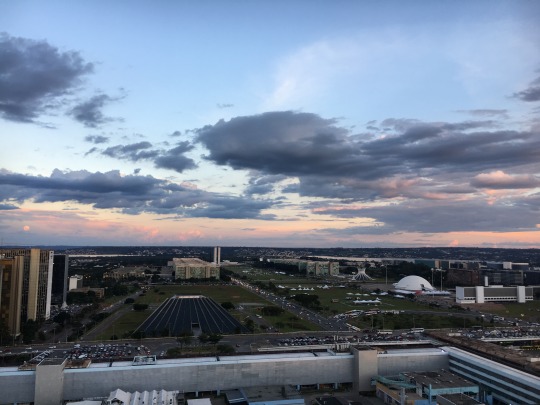
It ended on a good note tho. Taking off from the airport I was just able to make out the airplane shape from my window seat, and that made it feel like my trip was complete.
3 notes
·
View notes
Video
youtube
We family spent 5 days and 4 nights at Smugglers’ Notch Resort in Jeffersonville, VT. We stayed in a 3 bedroom unit in the Owls section of the Mountain. Check out our Vlogs of our adventures to be inspired to schedule your own family or extended friends - family trip to Smuggs and create lasting family memories. This is a quick overview of our itinerary. Please check back for a full trip report coming soon.
#hosted#smuggslove#smugglersnotch#vermont#vt#newengland#roadtrip#explorevermont#familytravel#blackfamilytravel#adventure#4kidstravel#intentionaltravel#makingmemories#explore#blackfamily#getoutdoors#diversifyoutdoors#bloggervibes
5 notes
·
View notes
Photo

I think “vacation vibes” may be one of the best feelings known to (wo)man! 🌊💙 www.beachbumwisdom.com #beachbumwisdom #transformativetravel #intentionaltravel #travel #wanderlust #blacktravel #blacktravelmovement #beachbumwisdomtravels #sacredtravel #sisterhood #tribe https://www.instagram.com/p/CLr_cF9rKkH/?igshid=25cst94qdoqf
#beachbumwisdom#transformativetravel#intentionaltravel#travel#wanderlust#blacktravel#blacktravelmovement#beachbumwisdomtravels#sacredtravel#sisterhood#tribe
2 notes
·
View notes
Photo

“Beautify your inner dialogue. Beautify your inner world with love light and compassion. Life will be beautiful.” 💙 For our upcoming retreats 🌏✈️ visit www.beachbumwisdom.com #beachbumwisdom #transformativetravel #intentionaltravel #travel #wanderlust #blacktravel #blacktravelmovement #beachbumwisdomtravels #sacrejjdtravel #sisterhood #tribe https://www.instagram.com/p/COOgaT5LqaS/?igshid=1frp9xcklhkqs
#beachbumwisdom#transformativetravel#intentionaltravel#travel#wanderlust#blacktravel#blacktravelmovement#beachbumwisdomtravels#sacrejjdtravel#sisterhood#tribe
1 note
·
View note
Photo

Must visit while traveling: fruit markets 🍍🥥🍌 www.beachbumwisdom.com #beachbumwisdom #transformativetravel #intentionaltravel #travel #wanderlust #blacktravel #blacktravelmovement #beachbumwisdomtravels #sacredtravel #sisterhood #tribe https://www.instagram.com/p/CMkwD3er1Me/?igshid=vlqo0gsfooam
#beachbumwisdom#transformativetravel#intentionaltravel#travel#wanderlust#blacktravel#blacktravelmovement#beachbumwisdomtravels#sacredtravel#sisterhood#tribe
1 note
·
View note
Photo

The best time to relax is when you don’t have time for it ✨ www.beachbumwisdom.com #beachbumwisdom #transformativetravel #intentionaltravel #travel #wanderlust #blacktravel #blacktravelmovement #beachbumwisdomtravels #sacredtravel https://www.instagram.com/p/CLn3f9MrGq8/?igshid=34udorx3daxz
#beachbumwisdom#transformativetravel#intentionaltravel#travel#wanderlust#blacktravel#blacktravelmovement#beachbumwisdomtravels#sacredtravel
1 note
·
View note
Photo

👣🌏 www.beachbumwisdom.com #beachbumwisdom #transformativetravel #intentionaltravel #travel #wanderlust #blacktravel #blacktravelmovement #beachbumwisdomtravels #sacredtravel #sisterhood #tribe https://www.instagram.com/p/CLfLcDvrThy/?igshid=3fayjmdss6y9
#beachbumwisdom#transformativetravel#intentionaltravel#travel#wanderlust#blacktravel#blacktravelmovement#beachbumwisdomtravels#sacredtravel#sisterhood#tribe
1 note
·
View note
Video
instagram
“Rejoice in the way things are. ✨ When you realize there is nothing lacking, the whole world belongs to you.” 🌀 ✈️ Upcoming Retreats 🇹🇭 Thailand, Aug 2020 (few spots left!) 🇲🇽 Tulum, Dec 2020 (spots filling!) 🇺🇸 Joshua Tree, May 2021 🇮🇩 Bali, Apr 2021 🇮🇩 Bali (Couples Retreat), Jul 2021 ���🇷 Costa Rica, Nov 2021 🇲🇽 Tulum, Dec 2021 www.beachbumwisdomco.com #beachbumwisdom #transformativetravel #intentionaltravel #travel #wanderlust #blacktravel #blacktravelmovement #beachbumwisdomtravels #sacredtravel #sisterhood #tribe #travelnoire #holistichealth #blackandabroad #girlstrip #mindbodyspirit #vacation #thefiveelementsretreat #retreat #vacations https://www.instagram.com/p/B_DGLv-h9vR/?igshid=1i6ymygavj36u
#beachbumwisdom#transformativetravel#intentionaltravel#travel#wanderlust#blacktravel#blacktravelmovement#beachbumwisdomtravels#sacredtravel#sisterhood#tribe#travelnoire#holistichealth#blackandabroad#girlstrip#mindbodyspirit#vacation#thefiveelementsretreat#retreat#vacations
1 note
·
View note
Text
Guadalajara
After a week in CDMX, I flew to Mexico’s second city, Guadalajara. It was my first visit so setting an intention was simpler: see the sights and get to know the city. This turned out to be pretty easy since there is not a whole lot to see or do there.
On my first day I headed to the historic center which consists of four plazas surrounded by government buildings, churches and shopping arcades. The plazas were all very pleasant and well-designed. The buildings were attractive if a bit monotonous (they love Tuscan arches there). The two standouts are the beautiful Cathedral and elegant Teatro Degollado. Also notable are the Jose Clemente Orozco ceiling murals in several buildings around the city. I walked west from the center to see more churches and parks as well as the University’s art museum.
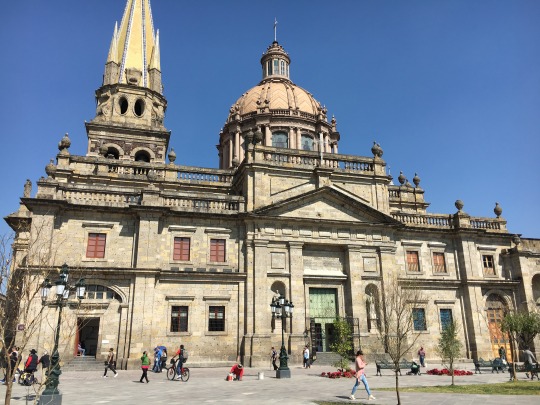
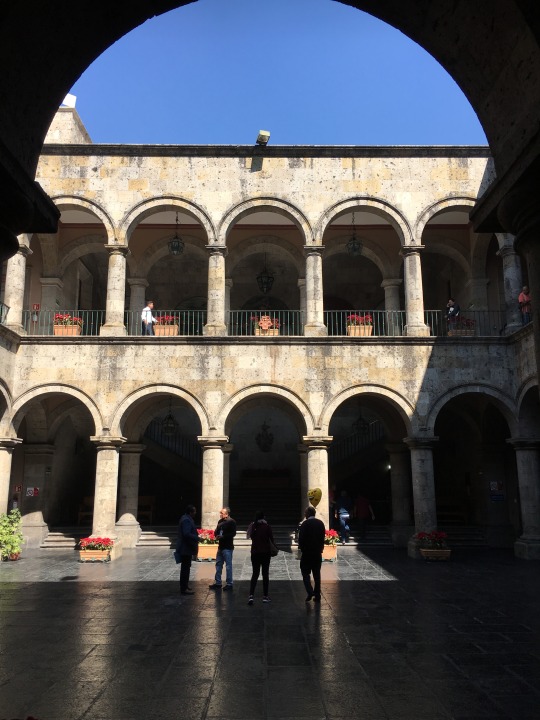

The following day I visited the nearby town of Zapopan, famed for its basilica (and the devotion of its congregation to Nuestra Senora de Zapopan, a little doll that sits above the altar). In front of the church is a lovely pedestrian walkway with some impressive public art. I also stopped at the local art museum which was refreshingly contemporary. In the afternoon I walked around Santa Tere, a traditional neighborhood that feels very authentically Mexican.
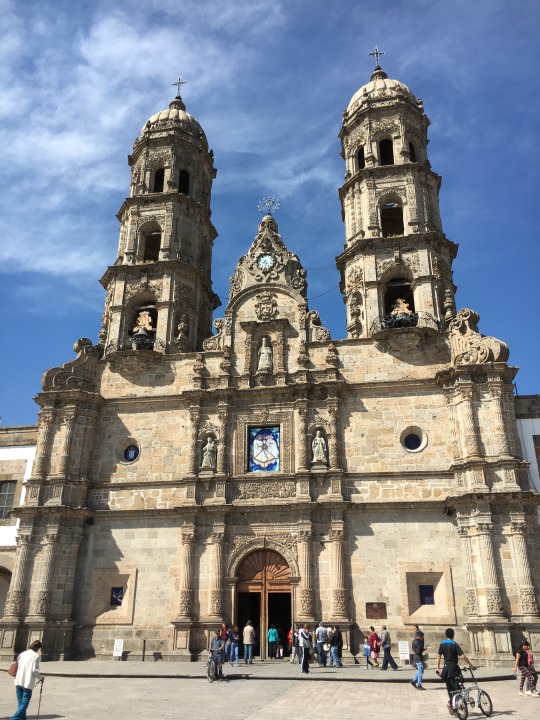
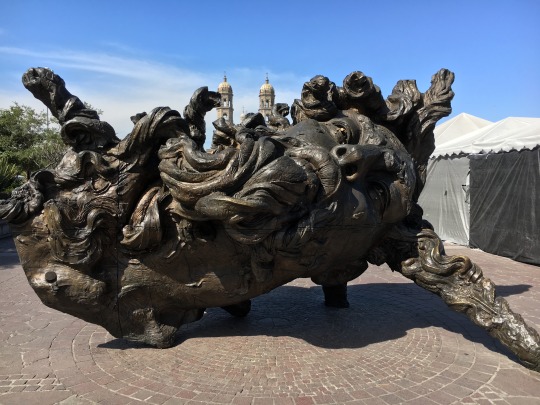

On Saturday I walked down Chapultepec, a hip area known for its restaurants, bars and clubs. It was still early however so there was not much to see. I then walked around Americana, an upscale neighborhood with some gorgeous homes, nice restaurants and hipster bars and cafes. (It reminded me of New Orleans’ Garden District.)
On Sunday I returned to the historic center, which was bustling with visitors and street performers. It was great to see all that wonderful public space so full of life. This time I walked east through the long pedestrian area of Plaza Tapatia to the stately Instituto Cultural de Cabanas. It’s a former orphanage that’s now a museum, focusing mainly on modern art. The central chapel has 57 Orozco murals, which are stunning. The numerous interior courtyards are full of whimsical sculptures, and the works in the gallery were imposing and impressive. I especially loved the temporary exhibition on the Portuguese futurist artist, Almada Negreiros. I also visited the unbelievable Mercado San Juan de Dios, a squat brutalist concrete building that houses a marketplace of nearly 30,000 vendors. You can find just about anything you could want in there (if you can actually find it).
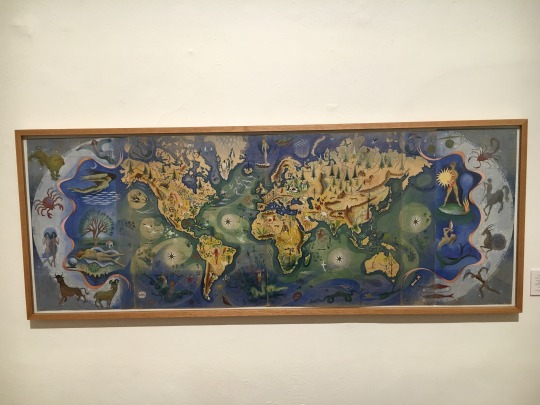


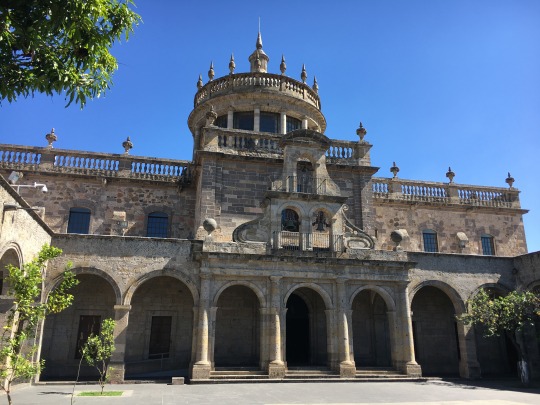
On my last day I headed out to Tlaquepaque, a nearby town that is supposedly an artist community. It’s well-preserved and full of beautiful old homes many of which now sell souvenirs, art and furniture. It’s like a Mexican Carmel or Sausalito. Still a nice place to wander around for a couple hours.
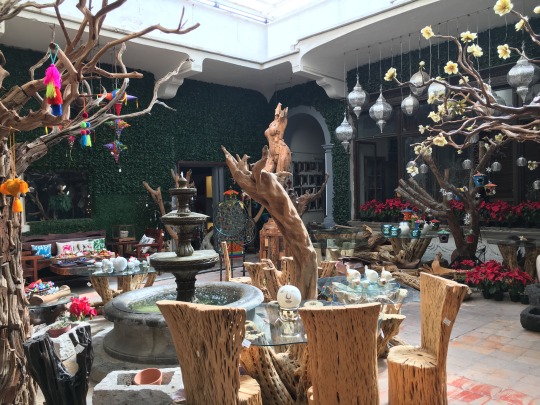

If this sounds like not much activity over a five day period, it’s because it is not. Guadalajara is lovely and has some definite highlights but three days is plenty of time there. (One popular excursion which I did not make is to visit agave farms and tequila distilleries outside of the city.) I spent a fair amount of time reading and watching Netflix, but I was OK with that. I knew I wasn’t missing anything, and it felt good to have downtime after being a busy tourist. Guadalajara also has a lot of great food as well as a strong hipster culture with all the craft beers and artisanal coffees that accompany it. Some of the local specialties, carne en su jugo (like a meat stew) and torta ahogada (fried pork on a French roll drenched in spicy sauce), did not disappoint. But I would not recommend the tejuino, a nauseatingly sweet corn drink (yes, corn).
The one last thing I will say about Guadalajara concerns the boys. I had heard that it’s a very gay city and that the guys are hotter than in CDMX. I do not know where it got that reputation. It’s a pretty conservative place with deeply ingrained Catholic guilt and ideas about machismo. Their online profiles are woefully lacking-- bad pics (or no pics), weak descriptions, even things like height left blank. They emphasize “discreto”, “varonil” (masculine) and “bi”. Most guys I talked to just wanted to see my photos. Several said they wanted to meet and then found excuses not to. And the few I did meet were not very skilled. They didn’t really participate; rather they just let sex happen to them, as if to maintain some plausible deniability.
All told, Guadalajara has some beautiful buildings, plazas, parks and art as well as some delicious food. But I don’t recommend the boys. And don’t stay too long unless you packed some good books or you’ve got some new Netflix shows to binge.
6 notes
·
View notes
Text
Memphis, Tennessee
My first night in Memphis I settled into my AirBnB-- a large ground floor of a duplex decked out in music-related imagery, furniture and knick-knacks-- then drove downtown for a late dinner at Belle Tavern, a newish upscale Southern restaurant and bar. The restaurant was closed (which saved me some money) so I ate off the bar menu and chatted with the friendly staff. That night I enjoyed the biggest, longest thunderstorm I’ve ever witnessed-- from the comfort of my bed.
On my last visit to Memphis I did most of the interesting things here so I decided to use this time to catch up on this blog, The Economist, my Portuguese lessons, travel planning and exercise. On my first day I finally left at 1pm and headed to Gus’s for their world-famous friend chicken. It does not disappoint. Then I headed to the National Civil Rights Museum which I had been sad to miss last time.
It’s housed in the former Lorraine Motel, where Dr. King was shot. When it opened in 1991 it was the country’s first civil rights museum (and it’s affiliated with the Smithsonian, which is how it became “National”). The museums I had just seen in Birmingham and Jackson are considerably newer and are in states that witnessed a lot more action in the struggle. (Tennessee was also a Jim Crow state but its racists were apparently less murderous.) The experience is heavy from the start. As you approach the highly recognizable motel, you see a wreath hanging on the balcony where Dr. King was felled. A plaque then directs your eyes to a run-down brick building across the street and the window in the former boarding house from which James Earl Ray fired the bullet (allegedly-- more on that later). After a deep breath, I entered the building.
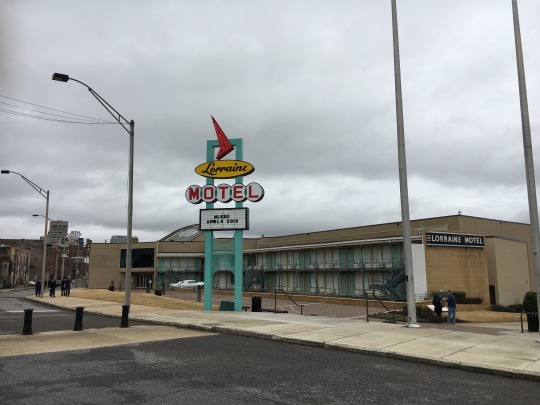

This museum stands out from the others I visited in two main ways. First its focus is national, not on a specific state. Second, it’s arranged not chronologically but episodically. So after introductory sections on slavery, Plessy and Jim Crow, each room tells the story of a notable episode during the struggle: Brown, Rosa Parks, Freedom Rides, Bombingham, lunch counter sit-ins, March on Washington, etc. At first I didn’t like this, as I thought, one, it would glamorize certain people and events while ignoring the “foot soldiers; and two, the historical timeline would become confused thus lessening the impact. The first concern was unfounded as the display were extremely detailed and thorough. And the non-sequential approach ends up also having merits; visitors can fully immerse themselves in the parts without getting lost trying to piece them together. The only problem is the crowds (which a sign in the lobby warned about). I ended up sandwiched between a tour group and a high school group and so scurried through some areas I would have liked to explore more. In part the museum design is to blame-- it’s confined to the original small structure of the Lorraine-- and in part it’s because addresses a popular, important subject, so the crowds are a good thing.
The museum also ends the story in a novel way. The passage of the Voting Rights Act is the first ending, but there are several codas. First, visitors enter the recreated rooms of the hotel where Dr. King was staying, and a window reveals the balcony as well as a view of the assassin’s building across the street. It’s very powerful. Following coverage of the immediate aftermath of his death, the displays then turn to the Black Power and Afro-centrism movements of the lates 1960s and early 70s, followed by the enduring legacy of the Civil Rights Movement. I think it’s inspired to point out that even tho the concept of Black Power doesn’t sit as comfortably with many whites as Dr. King’s non-violent resistance, it’s an equally important part of the same struggle. This museum also highlights throughout the many inequalities that blacks still face, such as the way most cities and schools are still segregated and the black political representation is still short of its potential.
And then things get really interesting... Across the street, in the boarding house where the assassin’s bullet came from, a newish wing examines the manhunt and trial that put Ray in jail (and displays the purported rifle). It then details the controversy that has surrounded the assassination ever since: the idea that Ray didn’t do it, that he didn’t do it alone and/or that he acted at someone else’s behest. Three separate commissions looked at the evidence, including the Justice Department and FBI in 1999 and 2000, and these displays very carefully and thoroughly present their findings. These investigations debunked some theories, but they raise A LOT of questions, and visitors are left to draw their own conclusions. Ultimately the more recent commissions decided Ray probably acted alone (tho they deemed a lot of witnesses, police and prosecutors unreliable) but he probably expected payment. From whom is unknown; the suspect list is quite long. It’s rare that a museum (especially a National one) would treat “conspiracy” theories so thoroughly and with such gravitas-- and not really try to dispel the conspiracy. Imagine the Kennedy Presidential Library doing that. I believe this reflexes the belief of some of the King family that Ray did not act alone and their attempt to uncover the truth.
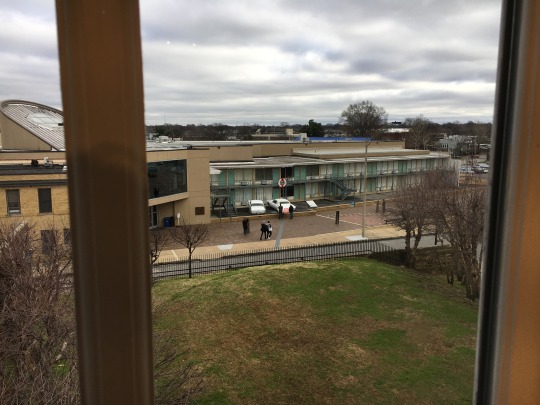
All that mystery made me hungry again so I ate at nearby Central BBQ which was obviously delicious. Then it was home for more catch up. For dinner I was craving something non-Southern so I went to Los Comelos. I thought it was a nice-ish Mexican restaurant, but it turns out to be a local family chain. Food was tasty enough tho. Then it was over to the Pumping Station for some drinks and conversation before bed.
On Thursday I woke up and headed to nearby Cooper-Young for breakfast. The neighborhood was not as happening as I thought it would be so I drove north up Cooper Street (Midtown’s main drag) to a good ol’ diner called Barksdale. After a cheap, basic, tasty breakfast, I continued north to the Overton Park neighborhood which was much more bustling than Cooper-Young. I drove in and around the park to peep some of the shmanciest homes in the city.
I then drove to Stax Museum of American Soul, the legendary studio that produced some of the biggest, best soul acts of the late 60s and early 70s. The 20 minute film that starts the tour really tells you everything you need to know, but the following displays go into much greater detail. I appreciated how they taught musical history, describing the sources of various influences like gospel, country and blues and how these all converged in Memphis. The museum also seeks to tell a broader story of black music, so it also features contemporaries and followers like Motown, Mussel Shoals, funk and disco and fairly give credit (and blame) where it’s due. The artifacts are numerous but not all that impressive-- mainly records and covers along with some clothes. (One big exception is Isaac Hayes’ gold trimmed, fur lined Cadillac with TV and fridge accompanied by a video of him describing how awesome it was.) The best part of course is the music and videos. The Stax story, like so many in the music industry, ends sadly and in bankruptcy. In fact it’s only in the fine print at the end that we learn the original building was torn down in the 80s and the current one is a recreation. That feels like kind of a gyp, but overall it’s a good experience and a good lesson in music history.
The rain returned that night so I just walked to the closet bar/restaurant, Young Avenue Deli. Seemed like a fun place (with a stage!). As I was leaving, trivia night was beginning. The first question was “What two countries share land borders with Sweden?” Is that what passes for trivia in Memphis?! On the way home I stopped for beer at the very friendly Hammer & Ale bar/store.
The next morning I set out for Nashville. I had planned to take the Natchez Trace Parkway most of the way since it’s a lovely, historic road. But it was raining across the entire state so I opted for the I-40 straight shot. Driving for three hours in rain was hellish, and the road was surprisingly crowded and torn up and the drivers pretty incompetent and/or inconsiderate (especially the truckers). But the scenery was pretty, especially the second half. I must have passed at least 20 state parks full of fall-colored forests, as well as some lovely water ways and charming farm houses. It almost made of for the misery of the drive.
2 notes
·
View notes
Text
Rio de Janeiro, Brazil - Week 1
The bus ride from Paraty to Rio was easy and uneventful. The road runs along the coast, but unfortunately the view is mostly obscured by overgrowth. I caught some dramatic, beautiful glimpses, but Brazil could learn from California and Australia. Upon arrival at my Ipanema AirBnB, I took a breath then settled in for two weeks of adventure....
My friends Scott and Tony had left Paraty a couple days early to come to Rio, so I met them for drinks and dinner Saturday night. We walked to a lively, popular-with-millenials section of Leblon and ate dinner at CT Boucherie, an established steakhouse-ish restaurant that was fantastic (and a great value for how much we ate and drink). Those guys had had a big night on Friday so we all turned in early.
And it’s good we did since Scott had a full day planned for us. We started at Parque Lage for breakfast at their famous restaurant. It occupies the courtyard of a crumbling mansion (now an art school) and sits just below Rio’s most famous landmark, Christ the Redeemer. It’s a setting made for Instagram, and everyone certainly took advantage of that. The food was pretty tasty for a place that could easily half-ass it. After breakfast we walked around the park a bit and saw our first monkeys!
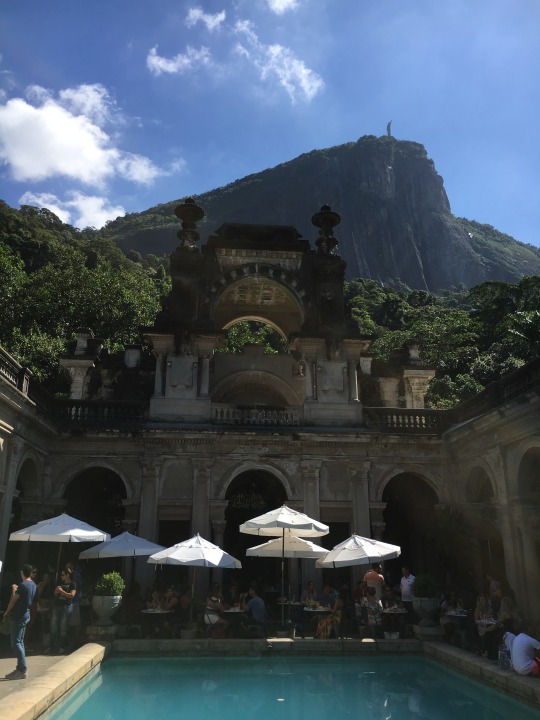

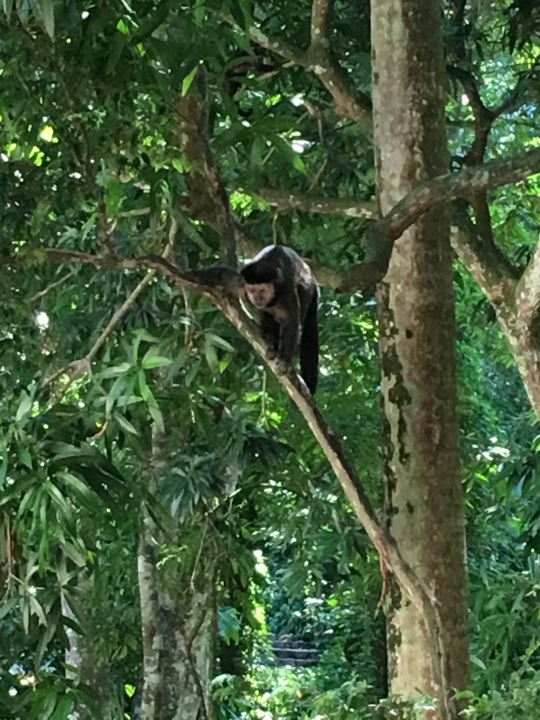
We then walked through Jardim Botanico, which appears to be the Beverly Hills of Rio. We walked through the Botanical Gardens as well, which are lush and beautiful. I think the most striking element were the massive tree trunks, some of which formed walls rising several feet above the ground.
From here we traveled back to Ipanema’s Praca General Osorio for the famous “Hippie Fair”, an arts and crafts market. I’m not sure what the big deal is-- it seems like every other crafts market I’ve seen. Afterwards the guys went to the beach, but I needed some literal chill time in front of a fan, so I lay low at my apartment for a while. We met up again for dinner at Zaza, a delicious Moroccan restaurant. It was the guys’ last night, but we were all pretty beat, so we called it early after a couple more beers.
Monday was shopping day, both clothes and groceries. I am not a beach person, and I was not prepared for how beached out Rio is. Even at nighttime in nice restaurants, people are in t-shirts, shorts and flip-flops. I needed some more beach wear to fit in (tho I only ended up finding one pair of shorts I liked). I met up with the guys again for lunch at Barraca do Uruguai, the most famous stand at Ipanema beach selling delicious meaty sandwiches. They had to get to the airport so we parted ways and I found myself all alone in Brazil....
On Tuesday I committed to the hard work of tourism. In the morning I took the metro to Centro, the historic center of Rio. I emerged at Rua Uruguaina into a hectic street bazaar. It was initially unnerving but a nice break from laid back Ipanema. Once I got my bearings I climbed up to Morro de Conceicao, a very old, Lisbon-esque street with cute (if shabby) townhouses, and then down to Praca Maua, the waterfront area that was revitalized for the 2016 Olympics. I first visited the Museu de Arte do Rio, housed in a beautiful colonial building attached to a gleaming modern annex. The view over Guanabara Bay is fantastic. The museum was showing two exhibits, one (”Mulheres”) featured women artists and had a lot of compelling pieces. The other was a history of samba. Once again I couldn’t understand the Portuguese captions, but there was enough music, video and glamorous visuals to make it fun nonetheless.


I walked across the plaza to Museu do Amanha (”Tomorrow”), a very modern “science” museum with a lot of interactive video displays and flashy installations for these selfie/social media loving Brazilians. The science was a bit thin; it starts with a brief history of the universe then focuses on humanity’s impact on the planet, for better and worse. But it was engaging.


I then hiked up another hill to the Mosteiro do Sao Bento, a monastery that is one of the city’s oldest buildings. Its plain, humble exterior belies an over-the-top opulence inside, a theme I found in every church I saw that day. Those early Portuguese settlers loved ornate, gilded wall reliefs like you would expect from Louis XIV.

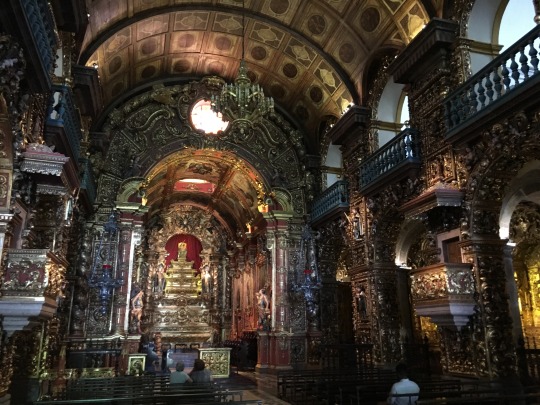
After a tasty chicken burger at the hip Cozinha Mironga I continued toward the waterfront to Igreja de Nossa Senhora Candelaria, the biggest of the city’s historic churches. The surrounding area houses lots of current and former government buildings, most of them imposing neoclassical edifices or fanciful Baroque colonial desserts (or both). I saw the Centro Cultural do Banco do Brasil (tho I skipped the current exhibition of Dreamworks art), Igreja de Nossa Senhora do Carmo da Antiga Se (which served royal functions when the Portguese throne decamped to Brazil) and Paco Imperial (the one-time royal palace). From there I walked through the extremely underwhelming (but historic) Arco de Teles into Travessa do Comercio, a charming cobblestone street of colonial townhouses, now home to outdoor cafes.
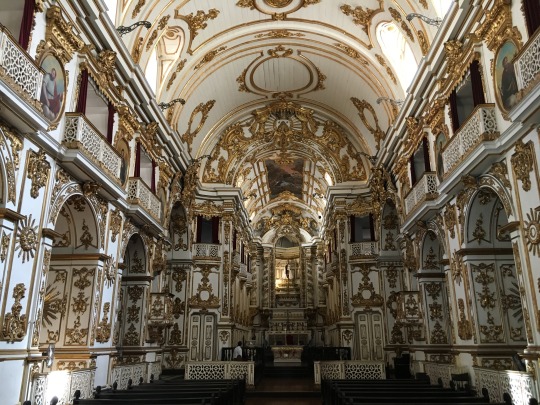
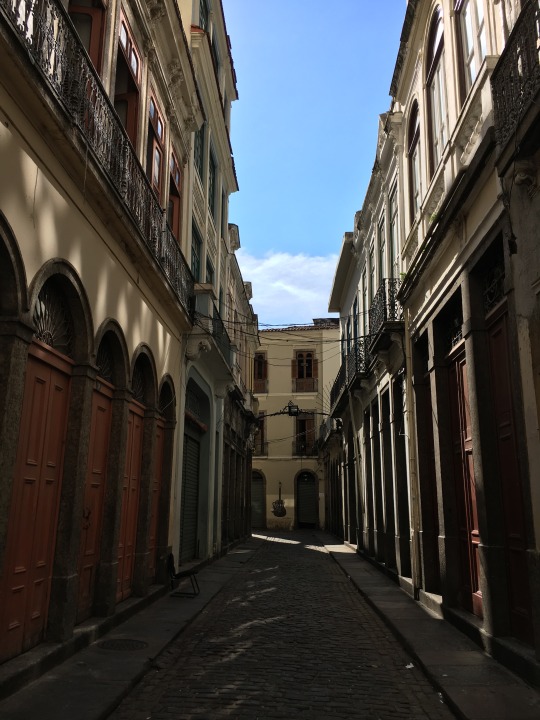
From here I cut across the hustling narrow streets of Centro to Largo da Carioca, a plaza surrounding by some atrocious 1960s skyscrapers (tho the Petrobras HQ is a marvel) and dominated by a very old church, Igreja Sao Francisco da Penitencia e Convento de Santo Antonio (phew). It’s beautifully restored and wins the gaudiest award in a very tough category. Not one inch of that chapel was left ungilded, an odd choice for an order who has taken a vow of poverty.
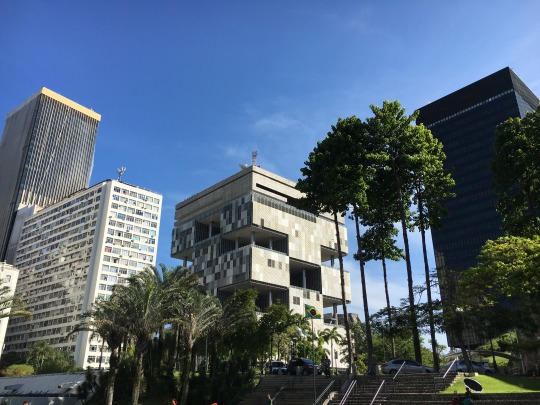

I then headed back up to Real Gabinete Portugues de Leitura, or the Royal Reading Room. It’s basically a library, and one of the most stunning I’ve ever seen. It’s three stories of books (over 350,000) in sumptuous but tasteful, muted decor. You can feel the knowledge surrounding you, and it makes you yearn to have more of it.
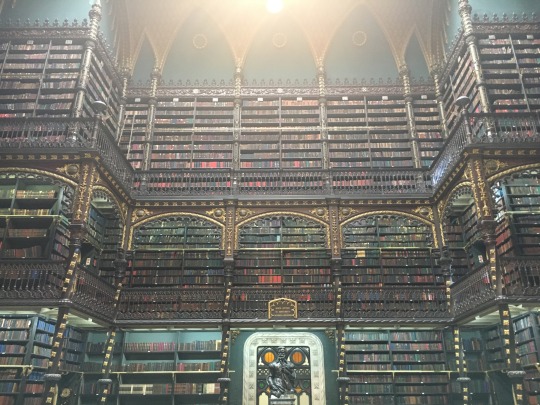
From there I veered west into Saara, a small grid of narrow streets that serves as an outdoor market and bazaar. You can probably find anything you need here and at a good price. At the end of it I found Campo de Santana, an elegant park with an odd assemblage of wild beasts-- cats, ducks, some sort of large fowl, and a cute, big rodent creature (capybara?). That was enough for one day so I headed back to Ipanema, had a big, tasty, cheap dinner at Frontera and went home to bed.
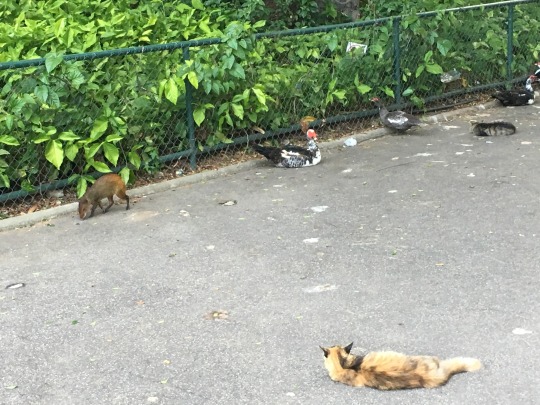
On Wednesday I headed back down to Centro to finish my tour. I started at the Museu Historico Nacional. I have a particular interest in history museums because a) I think it’s important to have some background and context when you travel; b) I’m a history nerd; and c) they are difficult to do well since good history requires a lot of text, which is not well-suited to a museum. Rio’s history museum is... decent. Housed in a well-maintained old fort, it could definitely use some refurbishing and some more engaging exhibits. After a respectable space telling the story of the indigenous people, it mostly focuses on the leaders and elites who steered the country from a Portuguese (and Dutch and French) colony into an independent republic. It has little to say about slaves, and I found no mention of the military dictatorship that ruled from the sixties to the eighties. (This is especially problematic given the current president’s favorable, revisionist view of the dictatorship.) But otherwise the narrative seems fair and accurate, if not thorough. It has almost no weighty artifacts, like original documents or “this was the actual thing that person used” items. It is mostly full of examples (of china, jewelry, slave shackles, etc.), paintings (many immense) and busts. Two awesome exceptions are a large array of carriages and early cars spanning three hundred years and an actual historic apothecary that was moved into the museum when it went out of business. I also appreciated that all of the displays had English translations tho they were riddled with errors. It made me wonder why the museum wouldn’t have them proofread before printing them up in a permanent exhibition.

From here I walked back to Praca Floriano (aka Cinelandia) which is the heart of downtown. The plaza is fairly non-descript, but it’s surrounded by some of the city’s most beautiful buildings: Theatro Municipal, Bibliolteca Nacional, Museu Nacional de Belas Artes and Camera Municipal. It was so stunning I stopped for lunch on the square and came back to see it lit up at night (when apparently the navy was attending the opera...).
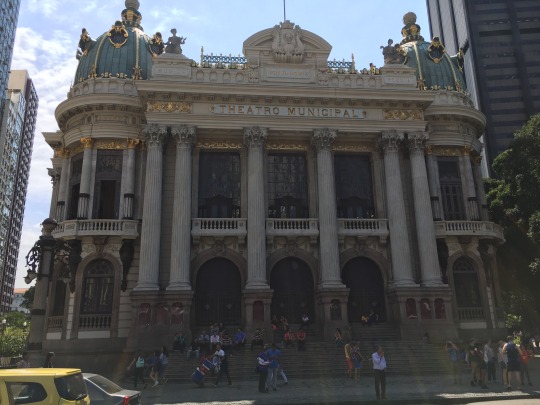
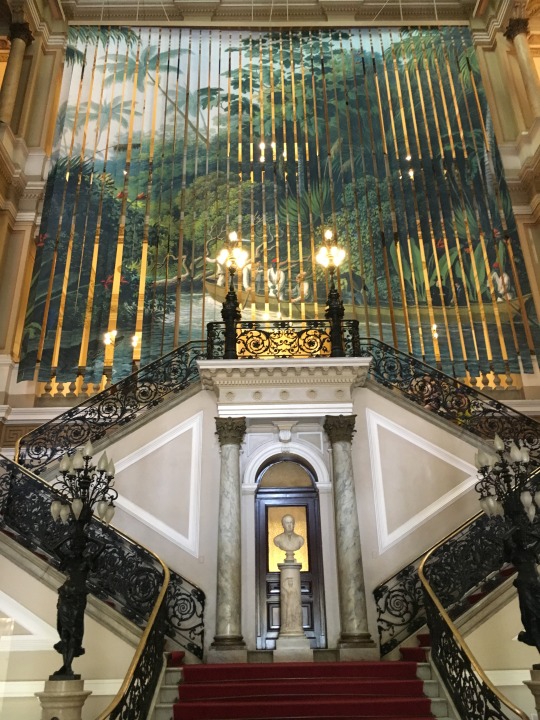

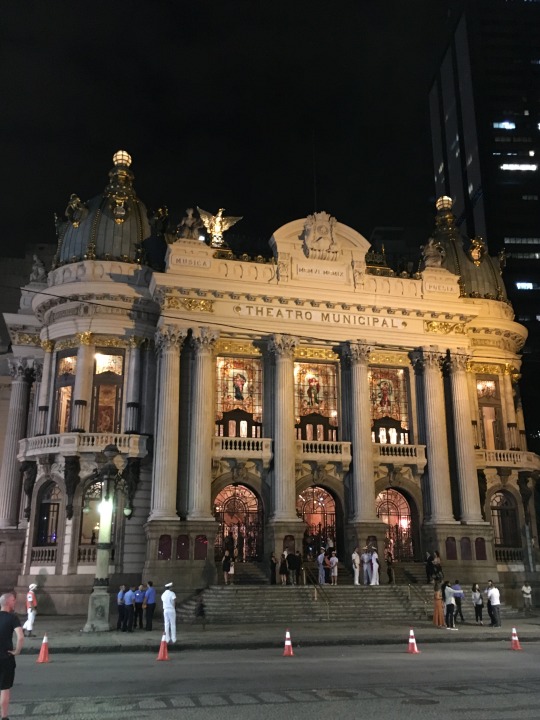
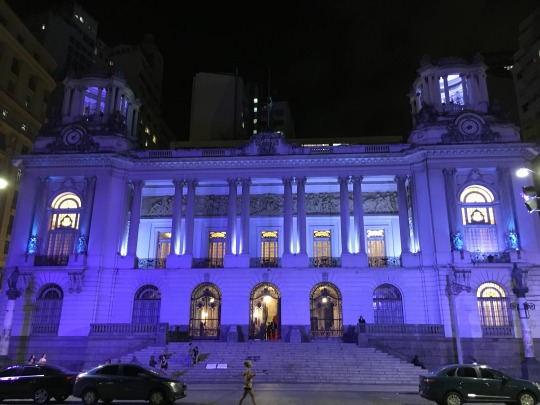
After lunch I continued west into Lapa, past the iconic Arcos (an old viaduct) and the peculiar Catedral Metropolitana de Sao Sebastio. It’s a brutalist cement cone modeled after Aztec pyramids, and it looks nothing like any church I’ve ever seen (tho not far off from St. Mary’s in San Francisco, aka “The Washing Machine”). After my initial shock and repulsion, I found it growing on me, if only for its boldness and break from tradition. It’s most famous for the tall stain-glassed windows (which are impressive in their size if not beauty), but what stood out to me was the main crucifix. It’s surprisingly small and suspended in the center of the cone about 30 feet above the altar. Jesus looks so vulnerable and alone, floating in an empty void. Of all the gory crucifixion scenes I’ve seen, this more than any other moved me and actually made me sad to think about Jesus’ plight.


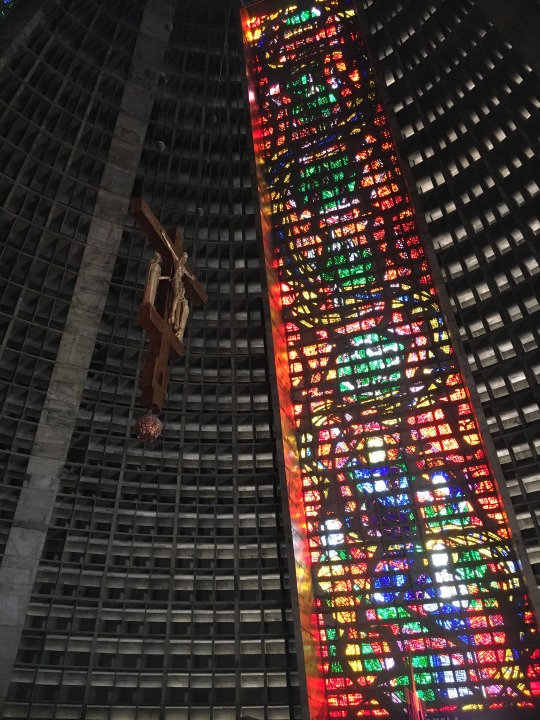
I then ventured further into Lapa. Nowadays it’s best known for its rowdy nightlife, and some of the bars were just starting to open up. Like much of Rio (and many Latin American cities), the area had traces of better days but now mostly looks decrepit. I made my way back, under the Arcos and headed to Cinelandia to catch the train home.
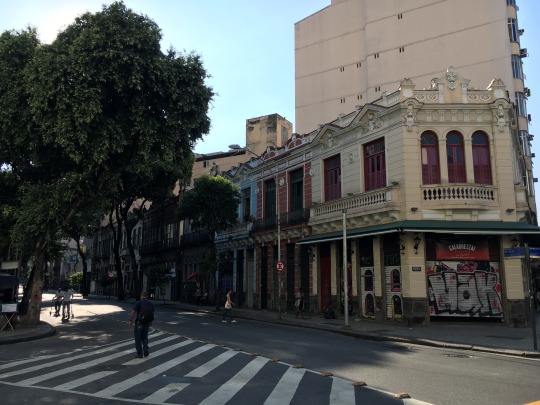
Thursday was considerably less ambitious. After a late start, I took the metro to Botafogo. Amid the usual urban grit of Rio are several beautiful old colonial mansions (as well as a notorious favela). I believe it was once an upscale artsy neighborhood that fell into decline, but some of the old buildings have been restored as museums or work spaces. Unfortunately, like so much of the city, they are hidden and inaccessible behind tall walls and fences. One beautiful exception is the Fundacao Casa de Rui Barbosa, once home to a famous writer and politician, now a museum. I didn’t go inside but the gorgeous grounds around the home are open to the public and look like a miniature botanical garden.
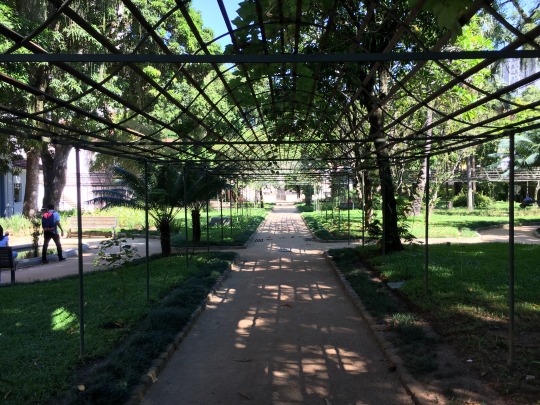
I made my way toward the next neighborhood, Humaita, and stopped at Cemiterio Sao Joao Batista, the final resting place for some of Brazil’s most famous residents. It’s quite beautiful and dramatic under the watchful eye of Christ the Redeemer. My last stop was Cobol do Humaita, a food market and dining hall, which are always pleasant to wander. The sun was going down so, after six days in Ipanema, I figured it was time to see the sunset on the beach. Obviously Rio faces East but the light is still nice.
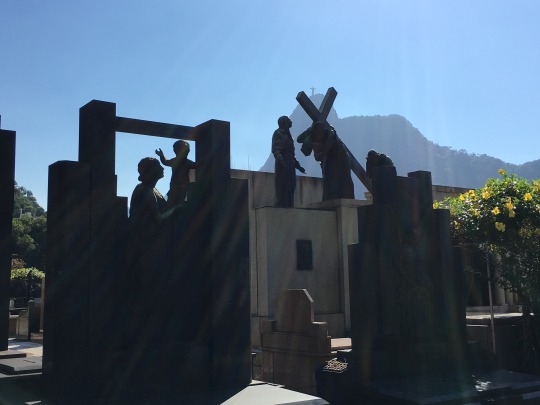
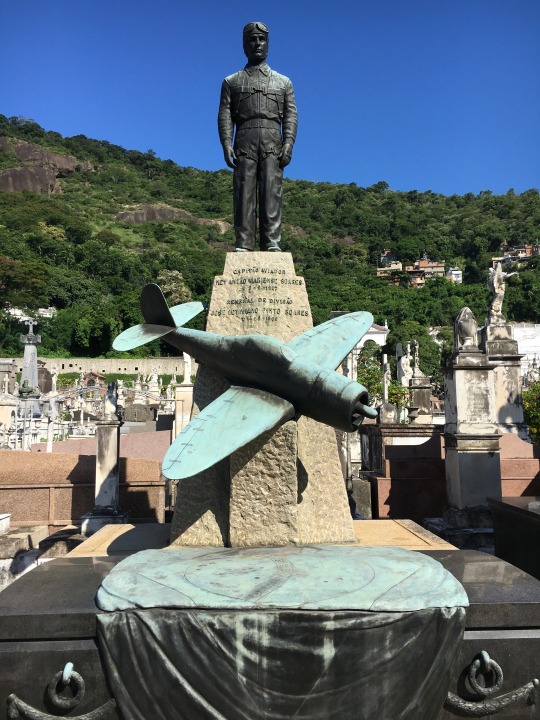

Friday turned out to be my most ambitious day and, painfully, the hottest so far. I returned to lovely Cinelandia and Lapa and visited the famous Escadaria Selaron, a public stairway that has been covered in a colorful tile mosaic in tribute to the people of Brazil. It’s pretty, fun and festive and swarming with tourists. Fortunately most people turn around at the top (if they get that far) instead of continuing into the beautiful Santa Teresa neighborhood. Like Botafogo, it’s full of charming old homes in various states of (dis)repair. But these are not walled off. And they run the gamut from cottages to palaces, so there is a lot of variety, both in architecture and culture. It reminded me of Russian Hill and Telegraph Hill. Also, this being a very steep hill, there are stunning views of the city and the bay from everywhere.


There is not much to do in Santa Teresa besides admire the loveliness, which probably helps keep the tourists away. Parque das Ruinas is the main attraction-- a crumbled mansion once owned by a salon-hosting socialite intellectual. It really feels like ruins, but staircases and walkways have been installed and the surrounding grounds turned into a park. The views from the top are spectacular. The small museum next door (Museu da Chacara do Ceu) hosts a private collection. It sounded interesting but appeared to be closed for construction.



I continued walking through the main commercial area which hosts some charming little boutiques, restaurants and bars (as well as a makeshift barber and a bar perched out on one of the viewpoints). I stopped for fantastic feijoada at Bar do Mineiro and more beer at the historic Bar do Gomes. Then, rather than walk all the way back down, I opted for the bonde, a cute little cable car that runs up and down the hill.



With a little daylight left, I headed back down to Botafogo and then over to Urca for one of Rio’s premiere attractions: Pao de Acucar (Sugarloaf Mountain). It stands tall at the north end of Copacabana and offers stunning views over the entire city and bay. It’s accessible by a sequence of two cable cars (gondolas), teetering at dizzying heights. It was crowded, as I expected at sunset, but not actually that bad. I stayed up there a while soaking in the “Marvelous City” and, like everyone else, taking tons of photos.


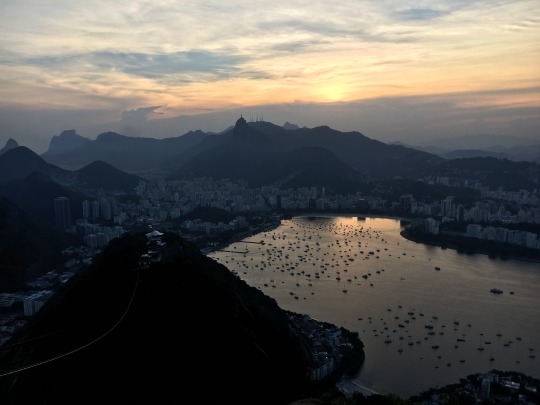
It was my first Friday night in the city, and I had nothing to do, which would have been a shame. But a guy I had been chatting with invited me to Paraiso do Tuiuti, a samba school. I demurred, concerned that I would not understand the instructions in Portuguese. But my friend then explained that it’s not a school so much as a club that performs sambas. The schools are formed in the favelas and compete at Carnaval every year. Friday night Paraiso was having a big birthday party and putting on a show for their friends.
The Paraiso clubhouse is across the street from Feira de Sao Cristovao, a kind of permanent country fair. It’s home to dozens of stalls selling all sorts of stuff, but at night, it’s mostly just restaurants and bars with a lot of karaoke. There is also a main stage with the kind of cheesy acts you would expect at a fair. And the crowd was overwhelmingly under 30, maybe 25. It was cute good times but I was not sorry to leave when my friend arrived.

The Paraiso do Tuiuti building is a big auditorium, not unlike a high school gym. A large samba band was in full swing in the corner of the mezzanine, and various people in uniforms, outfits and costumes were milling amongst the hundreds of guests. It all felt very festive, intimate and personable. A little later the performances started. My friend explained that each year at Carnaval each school performs a new samba and competes for first place (the schools are also organized like sports leagues with a top tier, mid tier, etc.). Paraiso do Tuiuti was performing their greatest hits that night in honor of their birthday (with songs going back to the 80s), and once they were done, a couple other schools-- Estacio de Sa and Mangueira (last year’s winners)-- performed as well. The whole experience was phenomenal and unforgettable-- the rhythms, the leg work, the costumes, the energy. It was a fantastic, only-in-Brazil night that a tourist can only hope to stumble upon.

Since I did not get home until 6am, Saturday and Sunday were my lazy days off before I returned to the tourist trail the next week....
1 note
·
View note
Text
Montgomery, Alabama
After Birmingham my next step was 1.5 hours south, the state capital Montgomery, another historically-charged city in the South. I read it was pretty sleepy (truth) so I decided I would just spend a few hours there but my time did not disappoint. Even more so than Birmingham, Montgomery is a step back in time with important lessons for the present. If only they would learn....
My first stop off I-65 was the brand new National Memorial for Peace and Justice. It opened last year to commemorate victims of racially-motivated violence, from slavery to police killings, but its primary focus is lynchings. Atop a grassy hill under a low slung roof hang 400 rectangular iron slabs, one for each county where lynchings took place (mostly in the South, but parts of the midwest too). On each slab is engraved the name of the county and the people who were lynched there (tho only a fraction of the victims and their stories are known). The pathway slopes downward in a loop until the slabs’ hanging effect becomes unmistakeable. Along the sides are engraved inspirational quotes and the shocking stories of some of the victims (one man was lynched after a coat went missing). The horrific details of torture and death are not spared. Outside this roofed area an identical set of 400 slabs lie on the ground like a field of coffins, waiting for each county to pick theirs up and display it, in an attempt to create a truly national memorial and a semblance of accountability. It’s deeply saddening and moving, a truly provocative, moving, overdue addition to our country’s national monuments. But unlike, say, the Vietnam Memorial, here you must have your bags inspected, pass through a metal detector and be told not to take selfies with the statues of tormented slaves in chains. How awful that those precautions are still needed.
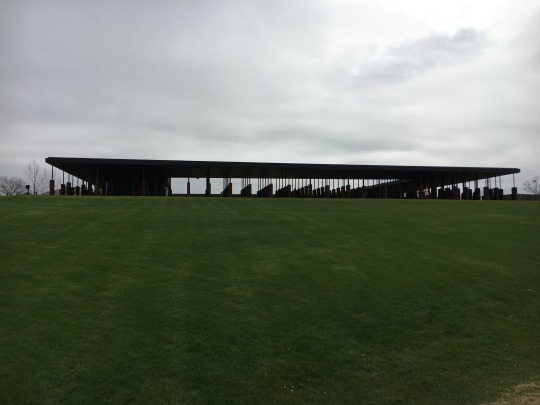
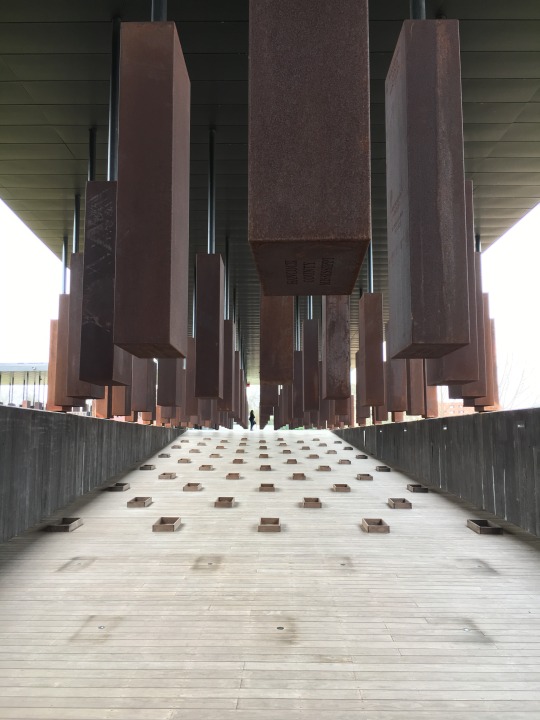


From there I moved to Montgomery’s most famous institution, the Rosa Parks Museum. It has two halves: a children’s wing that tells a very simplified version of black history from slavery to Jim Crow (all while sitting on a “time machine” bus with hydraulics driven by the robot Mr. Rivets); and a wing focused on Parks’ protest and the ensuing bus boycott. Annoyingly the ticket person didn’t tell me that the first part was for children when he sold me a ticket, so I wasted 30 minutes riding this Magic School Bus. At least I was all alone (except for Mr. Rivets) so I didn’t have to give up my seat to anyone.
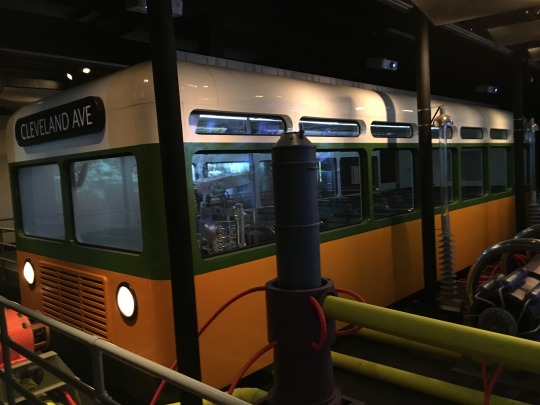

I decided to postpone the second half of the museum and walk through downtown Montgomery to the capitol building. The main street, Dexter Ave, has not changed much since Parks was arrested there almost 65 years ago. Most of the storefronts are deserted and judging by the signage left behind, they have been empty for decades. Some of the structures are quite beautiful and historic, such as the fountain at Court Square (originally a slave market and later the bus stop where Parks boarded that bus) and the Winter Building (where the Confederate leaders sent a telegram to their generals permitting them to fire upon Fort Sumter, which started the Civil War). But mostly it’s pretty bleak. Even the more modern government buildings at the end are really unattractive smorgasbords of too many architectural styles.
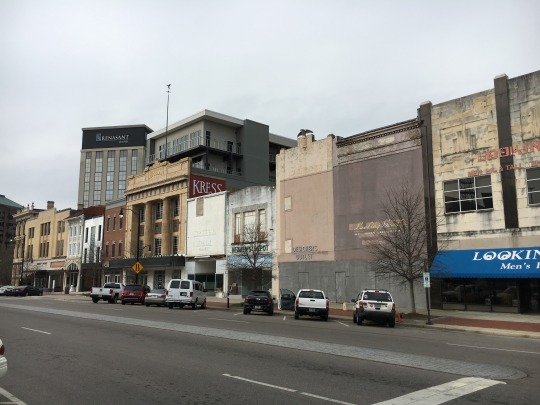

The capitol building itself is fairly nice. The grounds are well-maintained, and they had the decency to remove the Confederate flags from their massive monument to the Confederacy.... (Fittingly I had the disgust of seeing Jeff Sessions pass by as I was photographing the monument.) The building has undergone several expansions and renovations and even tho there has been some attempt to restore original details, it still looks like the interior came from Julia Sugarbaker of “Designing Women.” The walls are mostly painted pink and lavender, and the carpeting and chandeliers are quite... ornate. The original Senate chamber is where the Confederacy was born, and the front steps are where Jefferson Davis was sworn in as president. (Over one hundred years later, MLK would address 25,000 supporters from those steps after they walked in protest from Selma, the first attempt ending in the police severely beating the marchers.) Weirdly I think I saw maybe three people working in the entire STATE CAPITOL, not to mention the dozen I saw walking around the city for an hour. It is sleepy there....


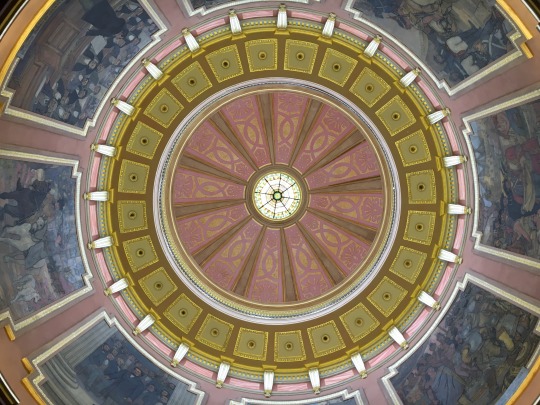
Montgomery has an interesting way of addressing its dual history as the birthplace of both the Confederacy and the Civil Rights Movement. The public signage is notably impassive: “This happened here. This happened there.” Of course true objectivity doesn’t exist-- they use “secede” and “secession” a lot, rather than, say, “rebel” and “traitor”-- but I do think the state has struck the right chord. They know how divisive their history continues to be. They clearly just want to acknowledge historic events and keep the government neutral in these heated discussions, a wise lesson for Alabama. (My biggest gripe is that I saw nothing acknowledging that Montgomery began as an important port for slave trading. Even the sign at the riverfront only mentioned that the port traded a lot of cotton, grain “and other commodities���.)
The non-state sites, such as the Rosa Parks Museum and the Lynching Memorial, stir enough passion to make up for the official indifference. My next stop was the National Civil Rights Memorial, an homage to 40 people who died as martyrs during the Civil Rights struggle, Some of them were active protestors; others were bystanders whose deaths helped propel the movement. Some are familiar, like Medgar Evers, Emmett Till and MLK; others are unknown. The terrifying, harrowing personal stories hit hard. Outside of the museum is a water sculpture designed by Maya Lin (of the Vietnam War Memorial) that is solemn and dignified, while its flowing water and circular design suggest the struggle has always been happening and continues to this day.
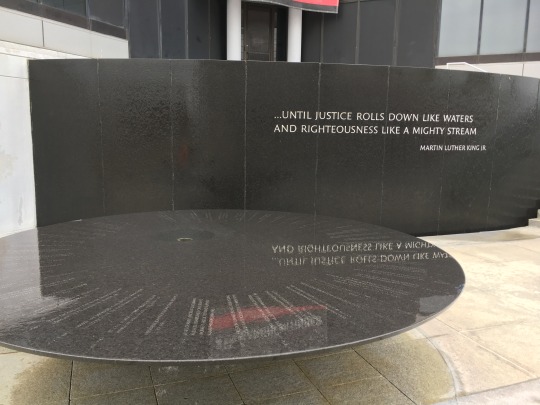
After this it was time for lunch at Dreamland, a small Alabama BBQ chain that was as delicious as it was friendly. It’s in an area just northwest of downtown by the riverfront that is undergoing a promising, well, gentrification. It’s full of beautiful old brick factories and warehouses that are being restored and converted into lofts, galleries, restaurants, bars, etc. It sounds tragic to coastal ears, but I think Montgomery could really benefit from development that draws in young people. And the restorations look remarkable.
After lunch I walked to Old Alabama Town, a collection of small old homes spread across several blocks that display what the city used to look like (I’m not sure when exactly). It was cute and charming but not architecturally noteworthy and hardly worth the walk over. I went back, past the Hank Williams statue, and popped over to the riverfront, also not worth the walk (at least not on a grey winter day).
My last stop was back at the Rosa Parks Museum to see the “grown-up” wing I missed before. It’s one of these museums that makes you sit through various presentations rather than proceed at your own pace. I’m not a fan of that, especially when I’m tired and trying to get to Mobile before the rain and dark arrive. The first video describes life for blacks under segregation and explains how the bus segregation was the most hated of all, which was actually pretty interesting. It tells Rosa Parks’ backstory as well, but although it explains how she worked with the NAACP, it glosses over how much of her protest was plotted in advance so that the museum can stick to the “just a tired lady on the bus” narrative. Once that video ends, some doors open and lead the viewers into a room designed to look like a bus stop, complete with the shell of an old bus. In the windows a video is playing, and for the next ten minutes actors in the video recreate the scene when Parks wouldn’t give up her seat. It sounds weird-- and it was-- but somehow it works. (Fun fact: under city law Parks was allowed to sit where she was and did not have to give up her seat, tho neither she nor the driver was aware.) Unfortunately I had to skip the self-guided history of the boycott (which is really the best part) because my meter was running out. I also decided to skip the Lynching Memorial’s sister Legacy Museum. It sounds amazing, but I wanted to get on the road and frankly, it sounds really depressing, and I had had enough for the day.
I then left for Mobile (to be continued) and while I was having dinner there I caught up on the news of the day. It turns out that while I was touring Montgomery’s and Alabama’s tortured history of discrimination, the US Supreme Court handed down a decision in the case of Domenique Rey. Rey is a Muslim man on death row in... Alabama. After exhausting his appeals, he asked that an imam be allowed to pray with him during his execution. The state told him that only the officially sanctioned (Christian) chaplain would be allowed. Rey appealed, citing the Constitution’s anti-establishment clause which forbids the government from favoring any religions. The Eleventh Circuit stayed his execution but the US Supreme Court decided against him. The new conservative majority of five thought that because his petition arrived just weeks before the execution, he was only trying to delay it (nevermind that he filed as soon as he learned the imam would not be allowed). Even many conservative commentators think this will go down as one of the Court’s worst decisions, along with Dred Scott and Plessy (which I learned about on the time machine bus tour!). Curiously, after the Eleventh Circuit stayed the execution, Alabama figured the jig was up so they changed the rule so that no clergy of any faith would be allowed to comfort the condemned during an execution. This echoes the state’s tactics during the fight against segregation, when they closed parks, pools, schools, etc. rather than integrate them. Alabama, will you ever grow up?!
1 note
·
View note
Text
On Becoming Unemployed and What Comes Next
Yet again, it’s been a LONG time since my last entry. But now that I’m unemployed-- and possibly looking for a career change-- I have more time and purpose for writing. I also have time for travel, which is what has prompted this writerly re-emergence. First a bit of back story….
I had been very dissatisfied with my job (digital music business development) for quite some time. The work itself was fine, but I was given too little of it, so I was extremely bored most of the time. When I found out that a couple friends would be getting married in Brazil this March, it seemed like a good excuse to quit and spend some time traveling. I wasn’t quite ready to make that leap tho so I booked a shorter trip to Brazil, along with a long weekend in Mexico City in January.
Then, rather suddenly, my company laid me off in mid-November, 10 days before my 39th birthday. The timing was poor (no warning, at the start of winter) but it was the push I had been waiting for. I immediately decided to travel for a while before figuring out what to do next. I booked a trip to NYC a few weeks later, extended my Mexico and Brazil trips and planned a road trip around the southern US in between. What better way to start the last year of my 30s?
New York was, as always, wonderful. The weeks before Christmas are the only time I enjoy the cold there, as the whole city dresses up for the holidays. But I didn’t really do anything. After a late start in the morning, I would venture out and walk around a bit before it got dark (at 4), then meet a friend for dinner and go home to watch TV. So basically what I would have been doing at home, only more expensive. So while I enjoyed my time there, I left feeling like I did not use it to the fullest.
How did that happen? I told myself that I’ve spent so much time in New York that I didn’t feel compelled to run around seeing everything I’ve already seen. But the truth was buried deeper. For one, as I’ve gotten older, I’ve become more homebound and less adventurous, more put out by the annoyances of travel and less enamored of its pleasures. Also, to my surprise, I was pretty stressed out-- and still am as evidenced by my inability to sleep through the night since I was laid off. And the wee-hour insomnia led me to sleep in late, which cut into my daytime tourism. To my credit, I toss and turn to a wide breadth of subjects:
Career
What do I want to do? Not tech, not anymore. But what else can I do in SF? Do I need to go back to school? Could I? How long will it take me to find a job? How much savings will I blow through until then? How will I adjust to a new job?
Health
Being unemployed and traveling makes it too easy to slip into bad habits. How do I motivate to ensure I still workout every day? And don’t drink too much? Or smoke? And eat healthy in Mexico and the South? I can feel myself getting flabbier….
Travel
What am I thinking doing all this travel? What’s even the point? Six weeks in Brazil, really? Two in Rio? It’s supposed to be really dangerous there, and I don’t speak three words of Portuguese. Can I handle all that driving around the South? Will I be as self-destructive as my last road trip? No matter where I go or how long I stay away, eventually I will need to come home to my lonely apartment and look for a job….
Birthday
This should not be a source of stress but it is. Almost all of my (childless) friends marked their 40ths with big parties and/or trips, and I feel like I need to do the same. I want to, but it’s so much planning, it just feels like a chore. Can I put on a good party? At what cost? And would anyone come on a trip with me? My friends are mostly partnered and busy often. The fact that I need to do all this planning by myself makes it feel like more of a burden and, combined with the uncertain attendance, makes me question if it’s worthwhile….
Love
This actually doesn’t stress me out much. I just don’t think it’s going to happen for me. So not stressful, but bleak.
At least I’m busy thinking while I’m not sleeping. Obviously some of these issues are bigger than this blog, but my focus now-- and one area that I have some control over-- is travel. It helps that I finalized all my plans and booked all my flights and accommodations. What keeps me up at night is questioning if all this travel is a good idea. It sounds like a great idea, but is it right for me now? Will I grow from it? Will I enjoy it? Or will I just go through the paces and count the days until I can get back to my own bed? I don’t know how many more opportunities like this I’ll have, especially while I’m (relatively) young. Will I turn my days into experiences or will they just pass?
And so my thoughts turned to my friend David, a slightly older, very well-traveled and self-aware friend of mine. (Incidentally David lives in NYC, and my visit happened to coincide with his birthday, so I got to go to his party which was one of my more fulfilling experiences on that trip. AND he’s married to a Brazilian.) David is fleshing out a concept called “Intentional Travel” (™, I assume). The idea is that the purpose-driven life doesn’t stop when you go on vacation. Life is more fulfilling and productive when you live with intent, and this applies to travel. It might apply even more actually. Whatever your reasons for travel-- relaxing, visiting cousins, trying new food, seeing where Lord Of The Rings was filmed-- do it with intention, and it will be a better experience.
I visited NYC without intent. And that’s kind of OK because it’s like a second home to me. But I can’t squander my other travels like I did that week. So now, in between vaccinations and AirBnB searches, I need to figure out what exactly I want to gain from my travels. Why am I leaving the comfort of my couch, going through the hassle of planning itineraries, digging into my savings, putting off my fitness goals, risking car crashes and muggings, learning a bit of Portuguese and putting my career on hold? What is my intention?
1 note
·
View note
Photo

Wow, it’s been a great year.
#momblogger#4kidstravel#family travel#blackfamilytravel#blackmomsblog#blackmomsblogging#intentionaltravel#adventure#bloggervibes
1 note
·
View note
Text
1 Day in Yosemite National Park with Kids
Yosemite National Park
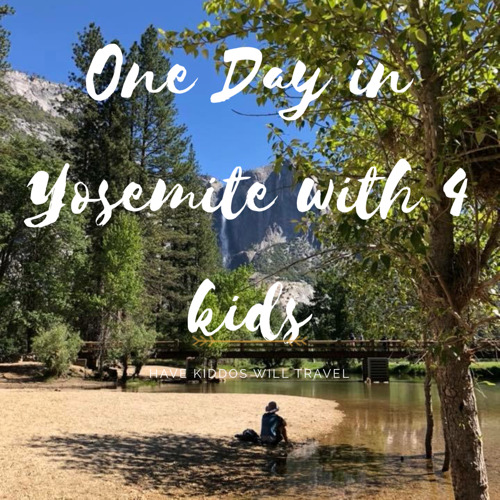
Day 2 of our family California and Pacific Coast Highway road trip started at the crack of dawn. We spent the night at the Springhill Suites Fresno after driving from Sequoia National Park. Our early rising children must not have gotten the memo that we were on vacation and were up and hungry at 4 am. Thus, our review of the Marriott Springhill Suites Fresno is that we slept well and the room accommodated our family of 6. Under a normal circumstances, Fresno would have provided us a great opportunity to buy groceries as they had a Costco and a Trader Joes. The bad news was that nothing was open when we were up and ready to start driving to Yosemite, so we were unable to stock up on goodies for the road. We did fill the rental gas tank at Costco, as the gas station was open at 6 am when we started our drive to Yosemite National Park.
A little background: our family is a seasoned traveling family and we traveled across the US with one small carry-on and a backpack for each person. This strategy aided in our ability to check into the hotel in Fresno with only our backpacks (I had packed overnight clothes and toiletries in the backpacks) and leave our suitcases in the car. When traveling with young children, less is more when it comes to one-night stays and need for fast transitions. I had no idea how important this actually was, until we witnessed how congested Yosemite National Park got in the afternoon. Trust me, you don’t want to dilly dally in a hotel or camp site if you want to make the most out of your day in Yosemite.
Family friendly (easy and flat) day hikes at Yosemite Valley:
Bridalveil Fall: a 0.5 round-trip; 20-minute (80 feet elevation change) hike leads from the parking area via a paved trail to the base of this waterfall.
Lower Yosemite Fall: (wheelchair accessible): 1.1-mile loop trail which takes 30 minutes with an elevation change of 50 feet.
Cook’s Meadow Loop: (wheelchair Accessible): 1 mile 30 minutes mostly level trail.
Mirror Lake Trail: 2-mile trail to the lake and back. Elevation change of 100 feet. This was our family’s favorite trail. We could have spent hours there.
Yosemite National Park is massive and is broken up in to 6 major areas: Yosemite Valley, Glacier Point, Wawona and Mariposa Grove, Tioga Road and Tuolumne Grove, Tuolumne Meadows and Hetch Hetchy. Due to our one-day trip to Yosemite, we decided to maximize our time and spend our day at Yosemite Valley prior to continuing our drive to San Francisco.
Pin for later:

Our family’s trip report of our time in Yosemite Valley.
Due to it’s location in the heart of the Yosemite National Park, this was a natural area of focus for our family. The Yosemite Valley offers unlimited array of activities that keeps the interest of young children. This impressive natural valley has the most outstanding concentration of waterfalls, granite walls – cliffs, meadows, wildflowers, trees and streams.
What we did at Yosemite Valley:
- Yosemite Falls was flowing with the spring runoff when we visited in mid-June (please note that it may be dry if you visit later in the summer). We chose to walk near and to the base, but you can also take a strenuous trail to the top.
- Half Dome is Yosemite’s most distinct feature as it dominates most views in the Yosemite Valley. You can enjoy stunning views of Half Dome from Cook’s Meadow, Sentinel Bridge, Tunnel View and Glacier Point. We stopped at each of these locations, but by far or favorite view from Sentinel Bridge and Swinging Bridge.
- As we arrived at the park early, we were able to find parking at the Yosemite Village Parking. This is not an easy task in the summer months, as folks tend to park for the day and not move their vehicle.
Getting around Yosemite: due to congestion, once we parked our car at the Yosemite Valley, we used the free shuttle to get around.

Source: www.nps.gov
- We explored the Valley Visitor Center, Bookstore, Yosemite Museum and watched one of two feature films: Ken Burns’ Yosemite: A Gathering of Spirits. Our kids loved learning about the Black Buffalo Soldiers that cared for the National Parks prior to the Rangers. We didn’t have time to watch the second film: The Spirit of Yosemite.
- We ended our day in Yosemite with a late lunch at the Majestic Yosemite Hotel.
Where we ate: While we fed our kids breakfast, my husband and I were intentional fasting and thus were ready for a good meal after our hikes. We took the Yosemite shuttle bus to the Majestic Yosemite Hotel to look into a table for a late lunch. I guess that it’s customary for parties of 6 to make advanced reservations. Ops, we were winging it and walked right up to the hostess to inquire about a table. If you’re foodies like us and want to have a nice meal while at Yosemite National Park, please call 209.372.1489 for reservations. We loved our time at the Majestic Yosemite Hotel and are already planning an adult only getaway there in order to tackle some of the more strenuous hikes and enjoy some rest and relaxation.
Learning about Yosemite National Park
As a homeschooling family, I was impressed by the variety of videos and educational material available online to help set the stage prior to our trip. I highly recommend that you spend some time here exploring them.
Pro tips:
- Arrive at Yosemite National Park as early as possible. If you don’t rise early, you are likely to encounter heavy congestion, especially in Yosemite Valley. We saw folks driving around in circles for hours attempting to find parking near the Yosemite Valley Visitor Center. Don’t be like them. The park’s printed materials warn of 2 to 3-hour delays, especially in the summer afternoons and weekends.
- Yosemite day visitors can park in three major parking lots: Yosemite Falls parking Lot, Yosemite Village Park Lot and at Half Dome Parking lots and then take advantage of the free shuttles to get to destination of choice.
- Park roads are steep, narrow and winding. Make sure to downshift even when driving an automatic car, in order to prevent car damage. If you or your kids get motion sick, do take motion sickness medication. You’ll thank me later.
- Wear sunblock and insect repellent. Ticks can carry lyme disease and prevention is key to enjoying these national parks.
- National parks are the natural habitat of wild animals such as bears, rattlesnakes, deer, cougars and others. Please educate yourselves and your children on safety and respect prior to exploring.
Lessons learned from our 1-day trip to Yosemite with young kids:
- You won’t get to see more than 1/6 of the park in that time, but it will still be a memorable and enjoyable trip. Planning is required and you should focus on the Yosemite Valley area. Spend time on the Yosemite National Park website getting acquainted with the locations of bathrooms, water refill stations and food. Pack a cooler with snacks and water for the drive in and out. Yosemite National Park is massive and once you cross the gate, you will have a lot of driving before you arrive at the Yosemite Valley area.
- Stay hydrated. We had traveled cross country the day before and had spent time hiking in Sequoia National Park. We were definitely impacted by the time change, elevations change and heat.
- Wear a hat even on overcast days. I’m naturally tanned, wore sunblock and my nose still got significantly sunburned. Reapply sunblock and insect repellent often.
- Not everyone has the same respect for nature and common courtesy as our family. This one is a tough one to deal with, as hiking and exploring nature is usually a peaceful and isolated experience for our homeschooling family. We were aware that we were traveling to one of the most popular national parks in the middle of summer, but boy was I shocked by the lack of common courtesy, manners and hiking etiquette that we witnessed. It didn’t ruin our trip, but it did irk me at times. Rude people suck! That’s all.
- I was also shocked by the lack of diversity at both of the California National Parks that we’ve visited. Our family loves our National Parks and we tend to spend a significant amount of time throughout the year, exploring the East Coast National Parks. While were accustomed to being one of few hikers of color, it was glaring at the lack of diversity at Sequoia and Yosemite National Park. We visited Shenandoah National Park just one week upon our return from California and compared to the west coast national parks, Shenandoah seemed like the United Nations. This observation has led me to research and follow individuals writing and documenting about brown people exploring our National Parks System. Representation matters: my mother calls us her Kennedy Kids because of our sense of adventure and desire to experience the world with our children. Thirteen years of us traveling with our kids to some underrepresented areas, has led to a passion to continue to inspire people of all backgrounds to get outdoors with their children and create a culture of exploration and adventure. These are our spaces, they’re amazing and everyone should enjoy them.
Things to do at Yosemite National Park:
- Junior Ranger Program: wow, the Junior Ranger Program at Yosemite is serious! In order to take the Junior Ranger Oath and earn your Patch and badge all of the following must be completed:
o Purchase a self-guided booklet at any Yosemite Conservancy Bookstore.
o Complete the booklet.
o Collect a bag of trash (I told you that they weren’t playing).
o Attended a ranger guided program.
- Take part of Yosemite Mountaineering School: provides outdoor adventures (professional guides for hiking, backpacking and rock climbing) for folks in various levels of experience. Reservations are required by calling 209.372.8433 or emailing [email protected]
- Take a photography class: Yosemite visitors can capture the beauty of the national park by taking a class by experts from The Ansel Adams Gallery. There are several free and fee-based classes offered weekly. You can learn more and sign up at Ansel Adam Gallery in Yosemite Village.
- The Yosemite Valley offers naturalist programs, walking – hiking, ranger guided tours, rafting, bicycling and sightseeing.
Access to Yosemite for all:
For such a massive park, I was impressed with how accessible Yosemite National Park is. Travelers in need in full access should pick up an updated Yosemite Accessible Guide at the park entrance stations, any visitor center or online by clicking here You will find accessible parking spaces just west of the Yosemite Valley Visitor Center which will place you centrally located in the Yosemite Valley. Did you know that Yosemite is the first national park to establish a deaf services program? They have full year language interpreters. Check out my friends at The Thoughtful Travelers Movement to learn more about the challenges faced by travelers with disabilities. Let’s make travel accessible for all.
Camping at Yosemite National Park:

Source: www.nps.gov
If you enjoyed reading about day 2 in our California and Pacific Coast Highway road trip, click here to read about Day 1 at Sequoia National Park. Day 3: Two Nights in San Francisco with 4 kids will be coming soon. In the meantime, click here for our live updates from our 8 day trip to California and the Pacific Coast Highway.
Check out our Vlog of day 2 which includes Yosemite and our drive - arrival to San Francisco.
youtube
#yosemitenationalpark#4kidstravel#adventure#explore#findyourpark#allkidsoutside#blackkidstravel#brownkidsoutdoors#waterfalls#costco#traderjoes#nationalpark#california#ca#caliroadtrip#californiaroadtrip#intentionaltravel#familytravel#roadtrip#hiking#foodie#tripreport#lovefortravel#travelblogger#largefamilytravel#borrowedtime#travelinspiration#momblogger#livetravelchannel#bloggervibes
1 note
·
View note